WEDNESDAY, MARCH 5, 2025
UIHC’s Eastern Iowa dominance
The new hospital is set to open April 28, $20 million under its half billion-dollar price tag.

Jack Moore Managing News Editor jack.moore@dailyiowan.com
Dale Ingle could feel rumbles in his house as excavators and tractors turned over black earth, laying the foundation for a new colossal structure that now peaks through the rolling hills of North Liberty.
“We have a night light when they turn on all the lights,
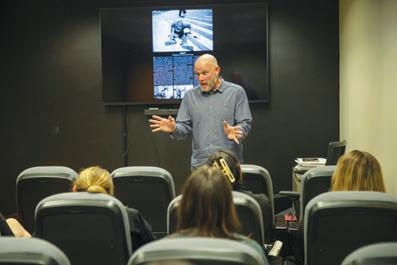
The book “USA 3.0” documents the changing

or when the sun goes down, then it pretty well lights up that half of the house,” Ingle said.
That “night light” in his backyard is a building University of Iowa Health Care has touted as their solution to what they’ve called a strained health care system the state has been feeling for years.
With seemingly endless lines of windows, white splashes of paint, and a prominent Tigerhawk logo, the UIHC North Liberty, or the North Liberty Hospital, is
poised to soften the escalating demand for orthopedics in Iowa with a price tag surpassing a half-billion dollars.
Encompassing 469,000 square feet on 60 acres of a former cornfield, the project has been under construction since 2021. Now, the white-paneled, L-shaped hospital is expected to open on April 28. But there have been bumps along the way.
Iowa City working to address food waste
A study shows about 20 percent of waste in Iowa landfills is food.
Isobel Perez News Reporter news@dailyiowan.com
Despite the rising cost of food placing a strain on consumers’ wallets, restaurants, and businesses, more food is ending up in Iowa landfills.
In its 2022 Iowa Statewide Material Characterization Study, which currently cannot be accessed without the use of the Wayback Machine, the Iowa Department of Natural Resources reported 20 percent of what makes up Iowa City’s landfills is food waste. That accounts for 568,197 tons of food contributed by homes, grocery and convenience stores, cafeterias, restaurants, and kitchens, with almost 7 percent of that, or 190,000 tons of food, still being unopened and in its original packaging.
The problem is worsened by the fact that, as the study states, one in eight Iowans is considered food insecure or lacks reliable access to affordable, nutritious food. As the prices of food and grocery items continue to increase, this issue will become more prominent as more households face poverty and hunger.
One of the reasons the study attributes to the mass amount of food waste filling Iowa’s landfills is lacking education about food labels such as “best by,” “sell by,” and “use by.”
Except for the case of baby formula, these dates are not mandated by law to be added to food and are added by manufacturers to inform consumers of the date the product will be at its best quality. This date does not necessarily denote when the food product is unsafe to eat or has gone bad, so one way food waste can be minimized by consumers is by not throwing away food solely based on its “best by” date.
The Food Pantry at Iowa, which provides free food and basic necessities to University of Iowa students, faculty, and staff, and distributed 92,603 meals in fiscal 2024, is aware of the importance of minimizing food waste especially when

A pile of food
many in the community struggle to access food. Because of this, the Food Pantry at Iowa has practices in place to ensure food is only wasted as a last-case scenario.
“If it is not expired or the shelf life is able to last very long, then we give out food,” Apeksha Adhikari, the basic needs manager at the Food Pantry at Iowa, said. “Even if things are two to three days expired, as long as it’s not dangerous for someone to eat it, and it is within the shelf life of that food, then we will still put it out.”
The Food Pantry at Iowa also rotates perishable food items, giving out food items closer to their expiration date sooner. This ensures these items aren’t sitting in the fridges or in the back longer than they need to and are placed on the floor for customers within the week they are donated.
Food Pantry at Iowa does not throw away non-perishable food items. If a can or a box of non-perishable food is damaged to the point
Former members urge students to take action against the loss of community
Emma Jane News Reporter news@dailyiowan.com
Following the University of Iowa’s decision to no longer recognize its eight diversity councils on Feb. 17, former council members expressed heartbreak over the value they said these councils provided to the entire campus community. Established to support faculty, staff, and students from historically underrepresented backgrounds — including women, veterans, LGBTQ+ individuals, and racial and ethnic minorities — the councils served as forums to engage in discussions and organize events. For Lina-Maria Murillo, a UI professor and
former member of the Council on the Status of Women and the Latinx Council, the removal of these groups represents a more profound loss: the erasure of vital spaces where like-minded students and professors could find community.
“I think [that’s] very purposeful,” Murillo said. “I think there’s a history to denying folks the ability to gather, especially folks who are likeminded, who have similar community or cultural interests or concerns.”
As a result of the UI’s Latinx Council no longer being recognized, Murillo said the Latinx graduation ceremony it previously hosted will not be allowed to take place this year — a loss she said breaks her heart.
“It’s one opportunity we all get to see stu-
dents, most of whom are first-generation Iowans whose parents are farm workers or meat packers in the state, and we get to see how proud their parents are when they graduate,” Murillo said, fighting back tears. “That’s gone. And so it’s just mean-spirited.” She likened the elected officials who initiated anti-DEI laws to “online trolls,” whom she described as enjoying the “petty cruelty” of eliminating any trace of DEI from public institutions.
“Our local state governments are passing laws to prohibit anything that even remotely smells of DEI. And the way that they are defining DEI is very broad and really ambiguous,” Murillo said.
DIVERSITY | 5A
Project managers have reportedly faced communication issues, market inflation, and physician shortages on their journey toward completion.

During the project, Senior Vice President for Finance and Operations Rod Lehnertz had oversight of UI Design and Construction, the department directly managing the project in conjunction with UIHC. He said the amount budgeted for the project was $526.6 million and noted they are ahead of schedule and under budget by approximately $20 million.
Lehnertz said up to now, the lack of facility space and equipment has been a problem. The growing demand for health care in general, he said, has led the hospital to turn away more than 3,000 transfer patients from other facilities on an annual basis.
“When we look ahead for this next 10 years, the thrust of our work is related to health care, and that’s out of necessity,” Lehnertz said. “To put it simply and bluntly, our hospital is at nearly 100 percent capacity, nearly 100 percent of the time.”
Now, the North Liberty Hospital is in its final stages — and it’s right in Iowa City’s backyard.
Addressing the patient problem
Orthopedics is a medical field focusing on bone, joint, muscles, ligaments, tendons, and nerve health.
UIHC is designated as having a “high-performing” orthopedics department by U.S. News and World Report in 2024, meaning it’s among the top 10 percent of orthopedic departments in the country, and the demand for orthopedic care is booming.
That demand is pushing orthopedics providers across the country to either double their caseload or increase the number of surgeons by 10 percent every year to keep up with incoming patients for orthopedic-focused surgeries, which becomes more common as people age.
In Iowa City, roughly 12 percent of the population is over the age of 65, according to the U.S. Census Bureau. Iowa is ranked 20th for the oldest population in the U.S. The increasing age of thousands of Iowans, coupled with increased demand, compelled UIHC to reconsider the location of their orthopedic clinic at the main hospital.

“We have a nationally recognized orthopedic department,”
Amy O’Deen, chief administrative officer of the North Liberty Hospital said in an interview with The Daily Iowan . “[The department] currently is in the lower level of our main hospital…So, navigating the massive complex of the UIHC and the parking and ramps and all those kinds of things makes it especially challenging for this patient population.”
In 2016, UIHC proposed expanding their Iowa River Landing Clinic to increase patient capacity. While the idea was abandoned in 2020 due to UIHC wanting a larger expansion, in its place was the project to build an entirely new hospital, seen today in North Liberty. Ultimately, a completed North Liberty Hospital will allow the entire orthopedics department currently housed in Iowa City to relocate to the facility, freeing up a space at the main campus including:
Over 100,000 square feet of space
107 in-patient rooms
• 81 exam rooms 11 operating rooms
How to specifically utilize those rooms once the orthopedics team has left is still up for discussion with the Iowa Board of Regents.
UIHC submitted a request to the State Health Facilities Council in February 2021 for permission to build the hospital. The council denied UIHC’s

request in a 3-2 vote. The Associated Press reported representatives from Mercy Iowa City — then a private Catholic hospital, but now UIHC’s Medical Center Downtown, after a 2024 purchase — argued at the council’s meeting a new hospital would harm Mercy and other community-based hospitals’ business.
Despite opposition, UIHC would get approval for the project from the state board six months later and began building within just a couple months, albeit under entirely different circumstances than any other UIHC project.
Unlike previous UIHC projects, the North Liberty Hospital’s contract for construction does not involve UIHC, though they do own the hospital. Rather, the actual contract is written between UI Design and Construction and the proj-
However, some hospitals were able to manage the inflationary increases. The Mayo Clinic Health System’s new hospital project in La Crosse, Wisconsin, was able to wrap up with an increase of just $20 million, bringing the total to $215 million for the 287,000 squarefoot facility that opened in August 2024.
The La Crosse hospital features a six-story space with accommodations for 96 beds, surgical procedural floors, endoscopy suites, cardiac catheterization labs, interventional radiology, medical-surgical units, an ICU, a family birthing center, and more.
“It really did take a focused effort among all these different teams coming together in a very coordinated way to ensure that everything remained on track .”
Amy O’Deen Chief administrative officer of the North Liberty Hospital
ect contractor JE Dunn, a national company with offices in Des Moines.
Lehnertz said the management change happened when the Iowa Board of Regents was disappointed with how the $392.7 million Stead Family Children’s Hospital project ended in 2019, as a multi-million dollar lawsuit with one of the contractors forced delays.
“The Board of Regents, rightfully so, said ‘How can you do things differently so that we can make sure we [have] a best project delivery university?’” Lehnertz said. “Since that time, we have shifted all project management, hospital or main [campus], to our Design and Construction and Facilities Management, which reports to me.”
Like the children’s hospital, the Regents sought to avoid budget increases with the new project, but this hope would be challenged come 2022.
A ballooning budget
In July 2022, amid record high inflation, foreign wars, and a country recovering from the COVID-19 pandemic, UIHC officials returned to the regents asking to increase their project budget of $395 million by $130 million.
The national average for constructing nonresidential building inflation at that time was 3.7 percent. But those numbers increased dramatically in 2022, rising to 12 percent — the highest inflationary period since 1981. Adding to the costs was a significant national labor shortage with 50 million workers quitting their jobs, up three million from 2021. In Iowa, the job market was the tightest it had been in recent years. Due to these challenging economic conditions, many hospitals under construction around the country faced considerable budget increases. The $123 million Tradewinds HCA Hospital in Florida increased its budget by 29 percent. A $619 million University Health System Women and Children’s Hospital Tower in San Antonio experienced a 32 percent increase.
The North Liberty facility, by comparison, has a three-story hospital connected to a five-story medical office building. A separate building supports a 36,000 square foot central utility plant designed to be expanded as time goes on.
Additionally, the North Liberty Hospital has a variety of features including:
Emergency department
24/7 pharmacy
• Areas for imaging
• A physical therapy
gym Education area for students entering the health care industry
44 clinic exam rooms
12 operating rooms
• Two procedure rooms
• 14 emergency care rooms
36 inpatient beds
These amenities were implemented using nearly double the amount of space as La Crosse.
UIHC officials ultimately presented their 33 percent budget increase — taking the total to $525.6 million — to the Iowa Board of Regents as the maximum amount of money they would need to complete the project. Funding is solely driven by the hospital’s revenue bonds, private gifts, and building usage funds, as opposed to state money according to Regent documents.
The budget increase request was approved, with the regents deciding delaying the North Liberty Hospital’s completion could hinder the timeframe of future health care projects such as a new inpatient tower on the main campus, the construction of which is slated to begin this year.
In November 2023, questions surfaced from the Regents regarding whether all of the budget increases came from just inflation.
The board hired national management consultant company Baker Tilly to complete an audit of the hospital project. The final report suggested communications mishaps between organizing parties and possible design changes later in the project could have contributed to the increased budget.
Baker Tilly identified kinks within the new managerial arrangement between UI Design and Construction and UIHC, with some parties reportedly unclear in regard to their respective responsibilities, particularly when it came to communicating with JE Dunn, the
private general contractor.
“We found that ownership of responsibilities, across the various stakeholders on the project, whether that be on the hospital side or design and construction side, and how they interacted with JE Dunn and other stakeholders, at times, those responsibilities could’ve been better communicated and better understood,” Heath Whitaker, senior manager at Baker Tilly, reported to the regents in 2023.

Whitaker also said there were some issues with the process of purchasing items, specifically from JE Dunn.
“We received word from JE Dunn that there were some items on the procurement list that they were not fully aware of their arrival and didn’t have complete oversight and insight into when those would be arriving,” Whitaker said.
He said more transparency between different teams would help avoid any late design changes.
“There could be increased visibility between the different project teams just to ensure the correct approvals are being performed to alleviate late design changes,” Whitaker said.
When questioned by the Regents on whether Baker Tilly found late design changes contributed to budget increases, Whitaker said they were unable to say for certain.
Despite the auditor’s report, both O’Deen and Lehnertz said communication worked well for the new project, as their partnership worked to keep the project ahead of schedule. Lehnertz anticipates the project will come in approximately $20 million under budget.
“It really did take a focused effort among all these different teams coming together in a very
coordinated way to ensure that everything remained on track,” O’Deen said. “We’re really proud that we’ll be completing the project on schedule within approved budgets, and I think it will have an outstanding outcome.”
Cornering the competition
In combination with the acquisition of Mercy Iowa City, the North Liberty Hospital’s emergency department, and the main campus ER, UIHC is positioned as the only hospital system for emergency visits in Johnson County. In fiscal 2024, UIHC saw more than 54,000 emergency room visits.
Lehnertz said the centralization of emergency rooms will be beneficial for the county as a whole because it allows the main campus to decompress their patient load to the other two hospitals.
“This fits perfectly — really ideally into what we would hope in serving the community from an emergency basis,” Lehnertz said. “Prior to all of this, there were two options: University of Iowa, which is the main [campus] right behind the field house, the main emergency room, and the Mercy Hospital emergency room.”
“Their’s [Mercy’s] was a quiet emergency room,” he continued. “Ours was an hours-of-wait emergency room, and a challenge for everybody, simply not because people weren’t cared for, but because it was overworked.”
What makes the new system great, Lehnertz said, is that each emergency room can handle whatever emergency comes up, but they also each have their own specialties in regards to specific ailments.
“If one isn’t feeling well, the downtown [campus] is a great place quick in, quick out,” Lehnertz said. “The orthopedics [hospital], if
LOCATION OF NORTH LIBERTY HOSPITAL
The new hospital is about 10 miles away from UIHC’s main campus.
Publisher Jason Brummond jason.brummond@dailyiowan.com 319-335-5788
Executive Editor Jami Martin-Trainor jami.martin.trainor@dailyiowan.com 319-335-6030
Managing Editor, News Jack Moore jack.moore@dailyiowan.com
Managing Editor Stella Shipman stella.shipman@dailyiowan.com
Managing Editor, Print Marandah Mangra-Dutcher marandah.mangra.dutcher@ dailyiowan.com
Managing Editor, Visuals Cody Blissett cody.blissett@dailyiowan.com
News Editor Grace Olson grace.olson@dailyiowan.com
Asst. News Editor Evan Watson evan.watson@dailyiowan.com
Politics Editors Roxy Ekberg roxy.ekberg@dailyiowan.com Liam Halawith liam.halawith@dailyiowan.com
Sports Editor Colin Votzmeyer colin.votzmeyer@dailyiowan.com
Asst. Sports Editor Brad Schultz brad.schultz@dailyiowan.com
Arts Editor Charlie Hickman charlie.hickman@dailyiowan.com
Opinions Editor Muskan Mehta muskan.mehta@dailyiowan.com
Visuals Editors Isabella Tisdale isabella.tisdale@dailyiowan.com
Emma Calabro emma.calabro@dailyiowan.com
Digital Editor Riley Dunn riley.dunn@dailyiowan.com
Audience Editor Shreya Reddy shreya.reddy@dailyiowan.com
DITV News Director Johnny Valtman johnny.valtman@dailyiowan.com
DITV Asst. News Director Jayce Bertrand jayce.bertrand@dailyiowan.com
DITV Sports Director Brady Behrend brady.behrend@dailyiowan.com
DITV Asst. Sports Director Collin Carrithers collin.carrithers@dailyiowan.com
DITV Tech Director Madison Johnson madison.johnson@dailyiowan.com
BUSINESS STAFF
Business Manager Debra Plath debra.plath@dailyiowan.com 319-335-5786
Advertising Director/ Circulation Manager Juli Krause juli.krause@dailyiowan.com 319-335-5784

you break an ankle, break a wrist, injure an appendage, is a great first stop because that’s where the orthopedics experts are.”
However, Lehnertz said the expertise at the main campus can handle the most serious issues.
That advice is especially important in life-and-death situations with the North Liberty Hospital having the lowest-level trauma center rating of the three locations.
The North Liberty Hospital has a level-four trauma center which, according to UIHC, provides advanced trauma care and life support, but it is typically in preparation for transfer to a facility, such as the main campus ER, which provides a higher level of specialized care with a “broader scope of surgical, specialty, and subspecialty services.”
When asked whether the emergency department will have rooms equipped with OB-GYNs and equipment used for birth, UIHC Communications Specialist Taylor Vessel wrote in an email to the DI that staff will care for patients in such conditions.

“Our North Liberty emergency care is equipped to treat and triage a vast array of emergent health issues,” Vessel wrote. “Most patients expecting a child will have a predetermined plan that they’ve worked out with the support of their OB-GYN, which would include where to go for needed services. If a patient in active labor comes to any of our emergency departments, staff will support them with the care they need and coordinate to get them where they need to go.”
Where they need to go, though, could be as far as 10 miles to the main campus location, which is a level-one trauma center: the highest possible designation. All ground transportation between the three hospitals will be handled by the Johnson County Ambulance Service, run by the county, not UIHC. But both Lehnertz and O’Deen said they have a great relationship with the service, and that will not change.
For patients who might come to the hospital experiencing a heart condition.
Vessel wrote they will go through patient priority
processes.
“For patients in need of cardiac catheterization lab services, staff at our North Liberty medical campus will utilize existing triage processes (through UI Health Care’s admission and transfer center) and transfer the patient to the most appropriate facility for care,” Vessel wrote.

Bradley Hawes, chief executive officer of UI Health Care, told the Board of Regents on Feb. 27 the main difference between the level of trauma centers was their ability to do general surgery.
“The difference between threes and fours is that they would have general surgery available consistently in that center, and so we are not planning on having general surgery, at least at the opening in North Liberty, but they do have general surgery coverage in the downtown campus,” he said.
General surgery encompasses some of the most common surgeries, which might include a skin graft, breast biopsy, or apendix removal.
Hawes also said they are exploring different options beyond just relying on the Johnson County Ambulance Service for people who may go to the wrong emergency department.
“We are partnering very closely with the emergency transport services,” Hawes said. “I won’t sit here today and say that that’s going to be a fail safe methodology. We are preparing in case somebody goes to North Liberty, as an example, because they live close.”

While orthopedics is the North Liberty Hospital’s primary focus, according to UIHC, the facility is in a phased development. That means the hospital will continue to expand through phases and is specifically designed for extensions. In an interview with the DI, Associate Chief Nursing Officer at UIHC Emily Ward emphasized that ability to expand.
“What we’re achieving here, it’s not only allowing us to grow services, specifically in orthopedics and

rehabilitation services, but it’s also freeing up space at the university campus,” Ward said. “It’s allowing us to expand services back there for other service lines and patient populations.”
As UIHC’s services expand, Steindler Orthopedics — a private practice with headquarters in Iowa City that had associated with then-Mercy Hospital — is also opening a new clinic for $30 million this year just down the road from the North Liberty Hospital. It will offer many of the same services. The new building broke ground in 2023 and is positioned to offer an alternative for orthopedic care in the area.
“The new facility will allow our team to expand the care we can provide for our patients, give the community choice in where they receive care, and will be conveniently located right off of I-380,” the clinic’s website states.
Alec Salter, marketing specialist at Steindler Orthopedics, said while it’s much smaller than the North Liberty Hospital location, the new clinic is in a location that can compete with UIHC.
“We do similar things. It’s a competing market,” he said. “It’s not something we’re all really concerned about, though, just because of our past performance compared to the university. We’re pretty confident.”
Money maker
The orthopedics industry is one of the highest revenue-generating medical fields, and while it’s still not exactly clear how much revenue the new hospital will generate, it will undoubtedly rake in hundreds of millions of dollars.
The national industry surrounding orthopedic devices alone is worth $16 billion with estimates of it growing to $19 billion by 2029. What makes orthopedics one of the most profitable medical industries is its growing demand.
According to data from HealthCare Appraisers, orthopedic-based surgeries like knee and hip replacements that rely on orthopedic devices, are expected to double from
2014 to 2030.
“These procedures are expected to increase dramatically in the coming years, with growth driven by an aging and more active population, improvements in implants and related technology, and the prevalence of obesity,” the Healthcare Appraiser website states.
Further adding to profitability, orthopedics has many subfields including radiology, physical therapy, durable medical equipment, and orthopedic-focused urgent care that can generate their own revenue streams — all of which are features of the North Liberty Hospital.
Despite the cost of building a new hospital over the past four years, UIHC has maintained a strong financial position. Their total equity is $3.2 billion, increasing by $508 million over the last fiscal year, according to international auditing firm KPMG.
But the new hospital comes amid some cutbacks, including the inpatient eating disorder program in 2022. While the outpatient eating disorder program continues to operate, UIHC announced three years ago the inpatient program closure allowed the redistribution of resources to focus on patients with “acute mental health care needs.”
Next door neighbors
A half-billion dollar hospital, though, has had an economic impact in the surrounding area already.
Dale Ingle, who lives right next to the hospital, said he’s seen apartment buildings go up in the last year. The development of what was once rows of cornfields is something he thinks was inevitable.
“It’s just continually shrunk to the point where I think it was going to do something,” Ingle said. “There were some wild turkeys and things that, of course, aren’t there anymore. I think it’s an inevitable type of arrangement where the two cities are going to meet.”
Ingle has lived in his house, now right next door to the hospital, for 31 years. He’s raised two
children and has two grandkids who played on swing sets in his backyard during the COVID-19 pandemic. Ultimately, Ingle said he expects the hospital will spur economic growth in the area.
“To the businesses around here, it should be a big boom of bringing in all the people and everything else,” Ingle said. “So, I think economically, I think it’ll do a lot of good for the area right around here.”
Ingle said, however, he wasn’t sure they needed such a large hospital, and having the North Liberty Hospital with Steindler down the road seemed excessive.
“Having two hospitals close by, because Steindler’s out here too, that is probably a little bit of overkill,” he said. “So, I’m not sure that we need a hospital quite this big.”
Just six doors down from Ingle lives Marvin Feigenspan, a man who’s worked as a tank mechanic in Europe during the Vietnam war, founded his own church, started a nonprofit, and has lived on the same street for more than 20 years.
Feigenspan said he sees the new hospital as adding value to his neighborhood. He said some in the community may be apprehensive about the dominance of UIHC, but he doesn’t see that as an issue.
“I haven’t heard anything toward the hospital in a negative way. Other than now, the university is the only major medical provider in this whole community,” he said.
Feigenspan said his biggest concern is the traffic that fills up his road, which is a single lane two way street. He said the morning and evening hours get especially congested, and he expects the road will eventually need to be expanded. But he thinks the hospital will promote economic growth in the area.
“It just brings it up to a level of, not only people who live here, but of specialties of other companies coming in, of an additional focus in our community, to train and equip other doctors,” Feigenspan said. “I just think it’s a plus all around.”
Next steps
With construction completed in December 2024, the next steps for the hospital include hiring staff, installing equipment, and moving furniture into the new space. Both equipment and furniture is budgeted at more than $92 million.
Hiring will be a challenge. Physicians are in short supply, and the demand for them keeps getting higher, posing potential challenges for hospitals across the country and UIHC. In 2021, the Association of American Medical Colleges reported there was a shortage of about 46,000 doctors in the U.S. with numbers expected to reach 124,000 by 2034. Ward said the hospital will have 700 staff members, which will be composed of new hires and transfers from other UIHC locations. The current number of people they need to hire for the North Liberty Hospital is a moving target. She said the type and number of staff they are hiring is fluctuating as they near completion of the hospital.
UIHC is hiring a variety of positions beyond just orthopedics. Positions in the emergency department, imaging, pharmacy, advanced-practice providers and more are also open.
She said the cutting-edge nature of the hospital will help attract the workforce they need for the hospital.
“[The hospital] has amenities that I think will allow our staff to flourish and be successful in their jobs there, and we hope it’s an environment that will attract additional workforce for us,” Ward said. O’Deen said as they enter the final stages of the project, she is excited to see the facility advance orthopedic care in the state as well as the country.
“This is really going to be a premier center of excellence for orthopedic care,” O’Deen said. “We’ve visited a lot of other places across the country, and I think it’s going to be second to none.”

OPINIONS
Voters choose values, not solutions
American politics have changed considerably the past few years. Local elections are proof.

Muskan Mehta Opinions Editor muskan.mehta@dailyiowan.com
Over the last few weeks, a familiar polarization took over Iowa City residents. On March 4, voters hit the polls, ready to vote for the open Iowa City City Council chair. Regardless of the winner, the tension leading up to Election Day took the spotlight.
Yet, Iowa City’s special election was not a partisan fight. It was the debate of which issues people care about more. With a focus on social issues, both candidates tried to demonstrate their platforms’ alignments with current political and social trends in an attempt to be perceived as the suitable option.
Both platforms’ websites include a brief outline of each candidate’s main concerns and how they have previously helped the community. With housing rights as a given for candidates Oliver Weilein and Ross Nusser, voters looked at their other promises in making a decision.
The top promises of candidate Nusser include affordable housing, expanded mental and behavioral health resources, support for those in need, and local food initiatives.
“With Ross Nusser, we’re not just electing a representative — we’re choosing a leader who truly cares,” Nusser’s campaign claims. He seeks to support local nonprofits and help local governments dealing with financial concerns. Nusser’s platform, while addressing community needs, focuses largely on tangible policy issues that can be shaped and implemented within the council’s capacity, aiming to provide relief to vulnerable populations.
His opponent Weilein takes on a more leftist approach. Along with housing concerns, reproductive rights and trans mutual aid are among Weilein’s cam -

This brings up an important question: What can Iowa City’s local council actually achieve for national and social issues? Not much. But that doesn’t seem to matter. Those issues are how leaders win, and that is how they show they care.
This isn’t new. When Trump ran for re-election, the same phrase kept emerging: family values. Ideally, one can’t run their campaign on something so baseless and vague. Yet, Trump did.
Rather than reflective, individual decision-making, voting has become a sports team — a sport about charisma, not skill.
paign issues. Weilein has also been more vocal about social issues — especially online. Following his 2018 tweet calling U.S. Immigration and Customs Enforcement officers “pigs” and “evil f*cking traitors,” he joined in the Feb. 3 protest against President Donald Trump’s mass deportations. His campaign reflects a commitment to addressing broader social justice issues, positioning himself as an advocate for marginalized groups to resonate with the younger, more progressive base in Iowa City. While Weilein’s positions are tied to pressing local needs, he focuses on national and global movements such as reproductive rights and immigration reform rather than purely local solutions.
While mental health resources may be vital, they aren’t thought of as the top priority for the city council — namely in a city with a university that already offers extensive mental health resources. As for immigration protection, local efforts are appreciated but are not a top priority for many residents.
And won. I wouldn’t say his victory was solely because of promoting family values, but it certainly had an influence. The Republican Party is a strong advocate for traditional American families, and Trump’s campaign successfully appealed to the public with his emphasis on heterosexual, pro-life, and ultimately picket-fence lifestyle. Although he couldn’t necessarily enforce “family values,” he gained support from those who have the same principles.
His opponent, former Vice President Kamala Harris, took the same approach. Instead of emphasizing specific policies — which she received criticism for — she rooted her campaign in relatability and authenticity.
“My values have not changed,” Harris stated, emphasizing consistency in her beliefs and actions. To reach younger voters, Harris became a prominent figure on platforms like TikTok, often using humor and viral trends, such as coconut memes, to engage with a demographic typically harder to reach through tra -

STAFF
Jami Martin-Trainor | Executive Editor
Columnists: Cole Walker, Muskan Mehta, Abigail Jones, Caden Bell, Reese Thompson, Grace Dabareiner, Julia Anderson, Aaron El-Kadani, Kennedy Lein, Jackson Mendoza
Editorial Board: Jami Martin-Trainor, Marandah Mangra-Dutcher, Jack Moore, Stella Shipman, Muskan Mehta, Charlie Hickman
COLUMNS, CARTOONS, and
EDITORIALS
ditional political methods. She showed the American public she stood with them while also running for them. This emotional appeal with her genuine desire to be in touch with the people propelled her campaign within months.
Just as Trump and Harris’ values influenced their policy decisions, Iowans want a leader whose decisions reflect their morals. That is exactly how American politics work. More and more, we’ve begun to decide our vote based on how we assume someone will approach certain policies. Giving an overarching idea of who someone is as a person speaks more volumes to citizens than specific policies ever could.
American history has proven this to be the case.
In the 1980s, former President Ronald Reagan realized he couldn’t run on economic policy alone. With his tax cuts only benefiting the rich, he shifted his campaign to more moral and social issues to draw in more Democrats. Thus, the idea of “Reagan Democrats” was born. Reagan recognized that many working-class Democrats who had historically supported unions and government programs were disillusioned by the Democratic Party’s drift to the left on social issues. So, he redefined the Republican Party by addressing concerns about law and order, traditional family values, and religious freedom — issues that resonated with socially conservative voters. These voters, many of whom might have supported Democrats in the past, shifted toward Reagan’s vision of America.
Gage Miskimen has been on the city council for Marion, Iowa, for the last two years and has noted this ongoing trend.
“Candidates should be asking themselves who they are and who they want to be for the community,” Miskimen said.
“Because we want leaders that are comfortable with these social issues and are a voice for the people.”
“It is tough in the Democratic Party, because a lot of voters aren’t satisfied with just policy alone,” Miskimen continued. “Showing and being there does numbers for voters, especially among those who feel underrepresented or unheard.”
And he is right.
Ideally, specific policies and changes would dictate which way people swing in elections. But America has changed, and along with it, the voting patterns. We look to our leaders for more than just public policy — we want a role model who thinks like us and thinks of us.
“People don’t want to vote for potholes in Iowa City. It is less about voting for someone that will make an instrumental change, but rather someone who they identify with,” Justin Cosner, University of Iowa director of graduate studies for the College of Liberal Arts and Sciences, said.
Although potholes might directly impact Iowa City residents more than immigration policies or mental health resources, they don’t say much about the candidate. Rather than reflective,
EDITORIAL
individual decision-making, voting has become a team sport — a sport about charisma, not skill.
This isn’t necessarily a bad thing — if done right.
The highest voter turnout for a special election occurred on March 7, 2023, for the development of a public water system. According to unofficial results, 476 residents of Johnson County voted. Presidential elections have always had the most turnout, even though some national policies might not directly impact Iowa City residents. The last presidential election had the highest voter turnout in Johnson County with 87,107 voters. Consequently, it’s safe to say not many people vote in local elections unless they are on the presidential ballot. Most Americans don’t know who represents them in the state governments, much less what they do. Still, the public pays trillions of dollars in taxes at the state level.
And so if locals run a campaign rooted in national, disseminated issues, heads will turn and head to the polling stations. The nationalization of district elections is inevitable, especially since the last presidential election was so prominent in the news cycle. We were constantly bombarded with new data, speeches, and media coverage.
So, instead of sifting through mountains of information and specific policies, many people just focused on the character of the candidate. Trump was a domineering, bold pick, while Harris had a caring, inspirational persona. Thus, the public was left to choose between which adjectives they preferred — even if they didn’t directly relate to being a strong leader.
This shift in focus from policy details to personal branding is what has defined modern elections, where the strength of a candidate’s identity often trumps the specifics of their platform.
As Cosner put it, “Playing on buzzwords is the game in town. But the alternative is like not playing at all, a choice to just give up.”
Gage Miskimen is a former executive editor at The Daily Iowan
where the pantry is unable to give the item to customers, the food pantry will place these items in the back for volunteers to take.
“We don’t really throw [non-perishable food] into the trash because we’re only mainly concerned about food that’s really going to expire,” Adhikari said.
Even when the food at the pantry expires, items are sent to be composted.
If the 854,000 tons of recyclable and compostable material that end up in Iowa landfills were actually recycled or composted, more than 1.4 million metric tons of carbon dioxide-equivalent emissions could be reduced, according to the Material Characterization Study. This would significantly reduce the amount of greenhouse gas entering the atmosphere and contributing to climate change.
Efforts to increase recycling and composting are already being implemented at the UI. The UI set a goal in 2010 of 60 percent waste diversion by 2020. While this goal wasn’t met, the university was able to increase its waste diversion from 23 percent in 2010 to 36 percent in 2020.
“The university uses a number of practices and training methods to reduce food waste,” Don Stanwick, the director of dining services at the UI, wrote in an email to The Daily Iowan. “That includes donation programs, adjusting menus to match demand and minimize overproduction, composting in all food prep areas, as well as the pulped waste, and prioritizing fresh food over frozen food.”
The UI’s food pulper, which was installed in 2012, assists with composting on campus. The pulper grinds up leftover food and extracts and reuses water for garbage disposal, which reduces the amount of greenhouse gas emission from Iowa City’s waste-water treatment plant.
In 2013, the food pulper is recorded to have decreased post-consumer food waste from 8,533 pounds going into the wastewater system per week to 2,800 pounds.
The UI also uses its menu planning and trayless dining as a method of reducing the amount of food students waste while dining, ensuring the UI is aware of all the
“Many universities are taking it upon themselves to also interpret DEI very broadly.”
While acknowledging the UI and other public institutions currently find themselves “between a rock and a hard place,” Murillo argued eliminating groups and classes that fall under the DEI umbrella is anti-democratic, as participation in these organizations is entirely voluntary and interest-based.
“The people that have not been talked to and engaged on these things are the people whose lives these changes affect every day,” Murillo said. “Staff, faculty, and students have not at all been brought into these conversations. We have absolutely no say in how these policies are applied and how they’re constructed.”
Sikowis Nobiss, founder of the local nonprofit Great Plains Action Society and a member of the UI’s former Native American Council, described the university’s decision to disband its diversity councils as heartbreaking emphasizing the lasting
food being produced, and students only take what they think they will be able to eat.
“To minimize overproduction, we use a menu management software, CBORD, which allows us to forecast a four-week cycle menu and to collect and track real numbers of the amount of food we plan to serve for any given meal,” Stanwick wrote.
Composting is also one of the ways grocery stores, such as Hy-Vee, can sustainably manage food waste and reduce the impact food waste has on the environment.
“Food that can’t be rescued and is no longer able to be safely consumed is collected through a partnership with GreenRU Organic Waste Diversion to turn food waste into compost,” Ivy Sprague, the director of strategic communications with Hy-Vee, wrote in an email to the DI
Hy-Vee, the UI, and the UI Food Pantry also partner with Table to Table to donate or receive donations of food that otherwise would have been wasted and dumped in Iowa’s landfills.
Table to Table is a nonprofit organization that seeks to increase food equity and reduce the environmental harm caused by food waste through their food collection and redistribution programs.
The organization rescues surplus food from ending up in landfills through its partnership with more than 100 food donors such as grocery stores, restaurants, warehouses, local farmers, gardeners, and transporters of food.
Table to Table is then able to direct goods to food pantries, free lunch pro-

their 2025 Johnson County Food Waste Profile.
Organizations like Table to Table are important not only for their environmental impact but also for their ability to fight food insecurity and bridge the gap between those who are and aren’t able to easily access food.
“There’s more than enough food in
“If it doesn’t get into the hands of somebody eating, it’s going into a landfill, and not only taking up space, which means we need more space for landfills, but also emits harmful emissions into our environment.”
Elizabeth Wagner Table to Table operations coordinator
grams, and shelter homes, which are some of the nearly 50 recipient partners with Table to Table who work to redistribute the food.
Through this collaboration, Table to Table has recovered 2.7 million pounds of food in the 2024 fiscal year, according to
impact DEI initiatives had on her as a UI student.
“The [DEI] programs they have placed at the universities make a difference for students. They are very helpful,” Nobiss said. “I am an example. When I first came here, I didn’t know a single soul.”
Nobiss recalled one of the first things she did as a student to find community was visit the Native American Student Association.
While the Native American Student Association and other culturally aligned student groups are not currently affected by anti-DEI legislation, Nobiss emphasized how having a space to connect with other Indigenous students has profoundly impacted her life to this day.
“The Native American Student Association changed everything for me,” Nobiss said. “I became the chair of the organization for a couple of years, and I learned a lot of great things that helped me further advocate for Indigenous peoples here to the point that I ended up starting my own nonprofit.”
Nobiss said she and her nonprofit organization have been pushing back against

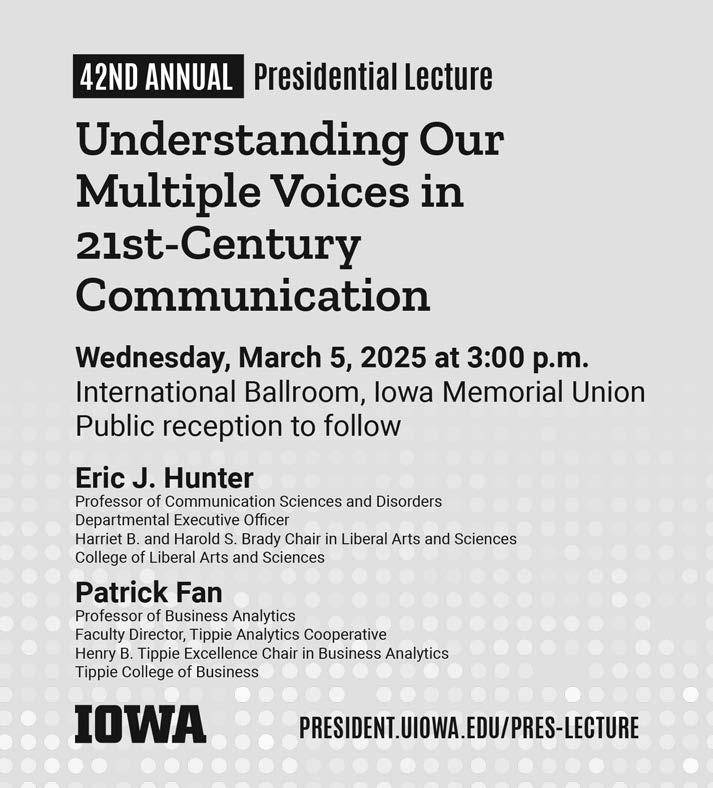
the system to feed everybody. It’s just an
inequitable system,” Natalie Leathers, the communications and development coordinator with Table to Table, said.
The work Table to Table does assists those who may go hungry due to the amount of waste that has been normalized
anti-DEI measures since 2021 when Iowa Gov. Kim Reynolds signed a bill banning critical race theory in Iowa schools, which Nobiss views as a precursor to the anti-DEI legislation now impacting public universities.
“We’ve been fighting the ban on DEI since before it happened,” Nobiss said.
Nobiss emphasized her view that DEI programs provide essential resources not only for students of color but also for disenfranchised white students and white women, making their elimination a widespread loss.
“I’m shocked that I don’t see more students on campus protesting,” Nobiss said. Murillo praised the power of student activism, calling students the UI’s most powerful stakeholders.
“They are relying on students’ complacency and apathy,” Murillo said of the Iowa
in the U.S.
Closing the gap caused by food waste would also create a greener environment where less space is needed for landfills and less pollution is entering natural resources.
“If it doesn’t get into the hands of somebody eating, it’s going into a landfill, and not only taking up space, which means we need more space for landfills, but also emits harmful emissions into our environment,” Table to Table Operations Coordinator Elizabeth Wagner said.
To help remedy the issue of food waste, alongside its food collection and redistribution programs, Table to Table is also partnering with Iowa City through its initiative, Love Food, Fight Waste. The partnership seeks to educate people on how they can reduce their own personal food waste, maximize the freshness of their food, properly utilize leftovers, and compost.
“We try to also educate people on that aspect because most food waste does happen in the home,” Leathers said. “So, that’s the easiest way for people to implement food waste reduction practices in their own lives.”
regents. “Because the second [students] get organized, and the second [students] start showing up, that’s going to be a problem for them.” Senate File 2435 mandated the elimination of diversity councils, and Jeneane Beck, the assistant vice president for UI’s external relations, explained the councils were initially organized under the university’s DEI office, which has since been restructured to comply with state law. Beck also pointed to Section D of the law, which prohibits universities from promoting or implementing programs, training, or activities related to race, color, ethnicity, gender identity, or sexual orientation.
“University attorneys reviewed the councils and determined they may also be considered a DEI office under the law and therefore non-compliant,” Beck wrote in an email to The Daily Iowan
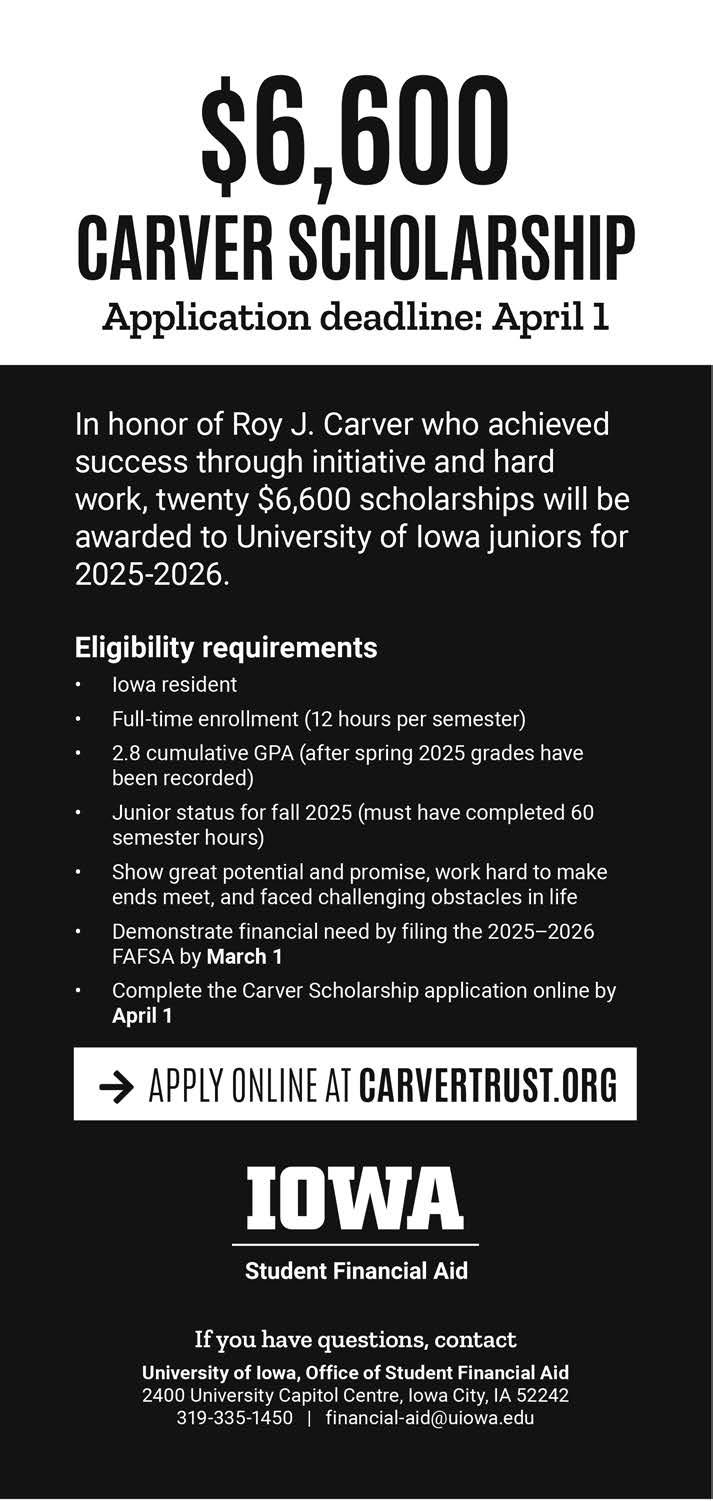
New book from DI workshop, VII, and SJMC
‘USA 3.0’ is a photography book covering issues that influenced the 2024 election.
Isobel Perez News Reporter news@dailyiowan.com
For the past five months, The Daily Iowan Documentary Workshop, in collaboration with The VII Foundation and the University of Iowa School of Journalism and Mass Communication, has produced a photo book project titled “USA 3.0,” capturing the changing political landscape in the U.S. over the past two years.
The book chronicles the 2024 presidential election cycle, documenting the political events leading up to and informing the election, as well as the events that followed the inauguration of President Donald Trump. It also includes coverage of the U.S. Supreme Court decision to overturn Roe v. Wade and events as recent as the California wildfires in January 2025.
“USA 3.0” is the first collaboration between the DI Documentary Workshop and The VII Foundation — an organizaiton that seeks to empower emerging voices through its educational programs. Through this collaboration, students participating in the DI Documentary Workshop could work alongside established photographers such as Ron Haviv and Adriana Zehbrauskas, learning from seasoned veterans.
“It’s nice for me, as someone who photographs for The Daily Iowan, to learn not only about their work but also get advice from them,” DI Visuals Editor Isabella Tisdale, who worked on the photobook as a photo editor, said. “It’s something that I probably wouldn’t have been able to do because I’m a freshman here. That’s not something that anyone can say at any school, that they’re able to collaborate with people at big agencies like this.”
Alongside learning from established journalists and photographers, workshop participants recorded in-depth interviews with the people most affected by the current political landscape.
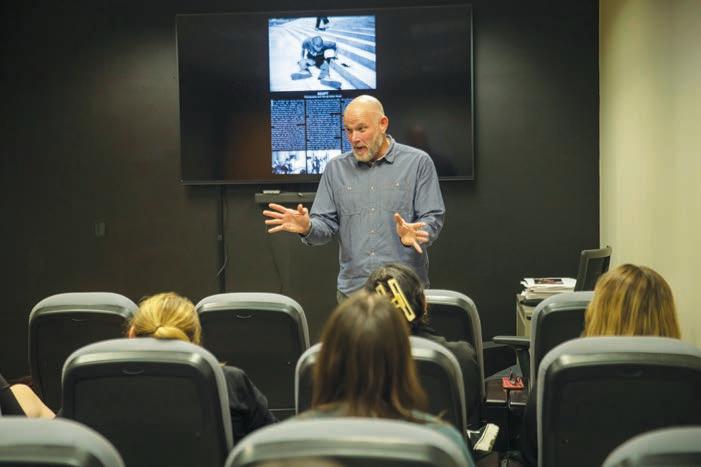
Daily Iowan Documentary Workshop, The VII Foundation, and the UI School of Journalism and Mass Communication.
“I talked to Joseph Silva, who took pictures of the LA wildfires, and seeing footage of people trying to save their neighbors’ homes. That was a completely different experience compared to observing it through the news,” Emma Calabro, a photo editor working on “USA 3.0” and visuals editor at the DI, said. “It feels kind of monumental for me because it’s a part of history, and I helped to create that spread and get that out there and learn about that.”
The collaboration between VII Foundation and the DI Documentary Workshop results from efforts by Danny Wilcox Frazier, the director of the Documentary Workshop and a contributing photographer with the VII Foundation.
Inspired by an idea from VII Foundation photographer Jordan Gale to create a zine of
the work produced by VII Foundation mem-
bers documenting the election cycle, Wilcox Frazier seized the opportunity to combine his work as a photographer with his role as an educator and mentor at the DI
“[The VII Foundation] is a bunch of highly committed, passionate visual storytellers who have been traveling across the country, telling stories not just of politics or politicians, but more importantly, the issues that drive politics in the U.S. from a very personal perspective,” Wilcox Frazier said. “So, we’re getting in close with people and showing how these issues impact their daily lives.”
“USA 3.0” explores just that, offering a personal perspective on the issues within the book because the photographers documenting the issues have worked alongside
their subjects for decades.
One of the largest sections within “USA 3.0” focuses on the issue of immigration, which became a top issue for voters in the 2024 election and constitutes 10 pages within the book.
“Immigration, it’s the border, it’s deportation, it’s people living in the United States that are trying to get their legal status,” Marandah Mangra-Dutcher, the assistant producer, a designer of “USA 3.0,” and managing print editor of the DI, said. “Knowing that and knowing the background on that topic and putting that on a page is really important so people can see this is what this is, what we’ve done, and this is where we are.”
While issues such as immigration have received a lot of coverage from the media, “USA 3.0” hopes to move beyond simply reporting on the issues, pushing beyond sensationalism to voice the stories behind headlines and politics.
“It’s important to show how we’ve gotten to where we are and how the United States is where it is so people can understand there’s a lot of issues and topics impacting how voters voted,” Mangra-Dutcher said.
“USA 3.0” provides a personal connection to the people impacted by issues in the U.S. through its photography and brief articles within the book. It offers important context on what circumstances informed the election, including immigration, abortion rights, and gender-affirming care, showing the real impact these issues had on the lives of Americans.
“I hope what people mostly get out of the book is that photography has this amazing ability to help people understand from a deeply personal place the commonality of our existence in society,” Wilcox Frazier said. “I hope that people are going to see themselves in the photos and see all that we have in common instead of a continuation of headlines and social media posts and cable news that’s really just about division.”
Iowa students concerned by uncertain future of FAFSA
Campaign promises by President Donald Trump about education leave FAFSA policies on shaky ground.
Anna Mitchell News Reporter news@dailyiowan.com
During his campaign, President Donald Trump vowed to bring massive changes to the U.S. Department of Education. These changes could include consolidating the department dramatically or dismantling it in its entirety.
Embedded in the Department of Education is the Office of Federal Student Aid, which is responsible for the Free Application for Federal Student Aid, also known as FAFSA. Alex Smith, a University of Iowa political science lecturer, said FAFSA is important to millions of college students.
“They provide funding to help make it possible for students to attend higher education institutions,” he said.
The funding covers student aid programs and a variety of loan programs, including loan forgiveness and alternative programs for individuals with a higher level of need. Under the Trump administration, students are questioning the future of student aid and the Department of Education.
Smith acknowledged while the presidential administration could not legally dismantle the department or reallocate the funding for federal aid, the U.S. system of government depends on individual branches using their power of checks and balances to defend against any abuses. However, it does not guarantee each branch will enforce this.
“If Congress doesn’t stop them and the court doesn’t stop them, then the answer is yes, they can do it,” Smith said.
He then reassured that even if the department were to get dismantled, student aid is unlikely to go away entirely.
“I don’t think student aid is just going to disappear, but the nature of it might change,” he said. “That would most likely be done legally through the official process — legislation passed through Congress and then signed by the president.”
Smith said moving the responsibility of student aid to the U.S. Department of Treasury or the states are possibilities, along
with moving aid out of the public sector altogether and putting it in private banks.
There is no way to determine if the amount of student aid being distributed would remain the same if any of these changes were to take place. This has led to significant concerns among students at the UI.
Madison Hovancik, a third-year student at the UI, said she would not be able to attend college without help from the federal government.
“There’s so many people out there, including myself, that rely on that money in order to continue [school],” she said. “It’s just frustrating, and you just have to wait and see what’s going to happen.”
Hovancik said she disagrees with any motion to reduce or change the federal programs, saying student aid is necessary for many people to achieve higher education.
“I don’t think it’s right at all. [FAFSA] was implemented in the first place to help people,” she said. “I don’t understand why we’re taking that away from people who want to further their education because not everybody does, so the people that do should have all the resources that they need if they aren’t financially stable.”
Third-year UI student Samara Summers said she received a significant amount of financial aid, which is necessary for her attendance at the university. She expressed her worry she could continue to receive less aid in the coming year.
“[I am] very worried — very deeply concerned. Even now, as I am getting further into my degree as an undergraduate, my aid has already been reduced,” she said. “Now, the fact that I am going to get even less is concerning.”
Summers described the time before college when she realized how much help she was going to need to pay for school and how the stress took a huge emotional toll on her. She said she is overwhelmingly nervous she would feel that again.
“I feel like I am going to have another one of those huge breakdowns about it,” Summers said. “I feel like things are only
going to keep getting worse. I have been so stressed about it.”
UI officials clarified there have been no changes to student financial aid and provided the university leadership’s public statement. The statement recognized developments at a federal level have the potential to impact the university and its students in various ways, including financially.
“We want to assure you that we are actively monitoring these changes and taking proactive steps to advocate on behalf of our university,” the statement read.
The university added they are working with the state legislature, relevant state and federal government agencies, legal experts, and a variety of associations to ensure campus remains up-to-date and aligned with new policies or regulations that may arise at the federal level. The statement acknowledged the potential for change to raise concerns and questions, saying the university is committed to providing timely updates and guidance as the situation evolves. UI officials declined to provide additional comment.


Overworked and underpaid: The indigent defense shortage in Iowa persists
The number of contract attorneys working continues to fall in the state of Iowa.
Bri Brands Politics Reporter news@dailyiowan.com
Combating an overwhelming caseload, Johnson County Con tract Attorney Eric Tindal often works 16 to 18 hours a day.
The long weekdays often over flow into Saturdays and Sundays for Tindal, who works in approx imately 20 different counties across Iowa.
“I might do a little bit less work during the weekend, but there’s not a day that I’m not doing emails or some kind of work on a typical day,” the criminal defense attorney said.
Tindal said on a recent Sat urday he had to visit a client in the Lee County jail — a trip that takes five hours. Work trips are not unusual on the weekend for Tindal.
For three years in a row, Iowa Supreme Court Chief Justice Susan Christensen has called for Iowa legislators in her annual “Condition of the Judiciary” speech to address issues with the indigent defense system in the state. The problem, how ever, stems back much farther than 2023. According to the Iowa State Bar Association, or ISBA, the number of contract attorneys — private attorneys who have a contract to take court-appointed, or indigent defense cases — decreased by almost 50 percent between 2014 and 2023.

In 2023, approximately 170 attorneys were employed by the Office of the State Public Defender, or OSPD, to represent poor and low-income individuals. Caseload far exceeds the capability of public defenders, according to the OSPD. The office identifies 561 contract attorneys.
Section 815.9 of the Iowa Code establishes an individual is deemed indigent if their income is at or below 125 percent of the U.S. poverty level, or $19,562 for a single person, unless the court determines they can pay for an attorney.
In her 2025 “Condition of the Judiciary” speech, Christensen said the majority of the approximately 87,000 serious criminal cases in fiscal 2024 were entitled to court-appointed counsel. Christensen spoke about how the contract attorney shortage results in criminal defendants sitting in jail for long periods of time and not receiving a speedy trial, as guaranteed by the U.S. Constitution’s Sixth Amendment.
Countless lawyers are experiencing extreme burnout, Christensen said, but feel guilty leaving their work behind and, in effect, leaving clients defenseless and heightening the workload for other overworked contract attorneys.
“Contract attorneys are crucial to the system, yet they find themselves caught in a relentless tug of war — feeling undervalued because of low compensation while struggling against the pressure to keep going,” she said.
Overworked and underpaid
Iowa Rep. Brian Lohse, R-Bondurant, serves as the chair of the House Justice System Appropriations Subcommittee and has been advocating for a continued increase in pay since his first day in the state legislature.
Over the last two years, Lohse said he has been able to get the pay rate to increase by $8 an
hour, from $78 to $86 per hour for Class A felonies. His goal, however, is to see the pay reach $100 an hour at the minimum by the time he retires.
The current pay rate for contract attorneys is $86 per hour for Class A felonies, $81 per hour for Class B felonies, and $76 per hour for all other types of cases, according to the Iowa Legislative Services Agency.
The Iowa Legislative Services Agency defines the different classes of felonies:
Class A felonies are the most serious offense under Iowa law. Examples include sexual assault resulting in serious injury and first-degree murder.
Class B felonies are one step below Class A felonies, with common examples being murder in the second degree and multiple acts of child endangerment.
Tindal said while pay rates may sound substantial, they are just barely enough for the average attorney.
“When you figure that the average law firm needs $75 an hour just to keep the doors open, $76 an hour just isn’t doing it, so increasing the hourly rate significantly is a must,” he said.
According to the American Bar Association, a lawyer should dedicate no more than 2,080 hours per year to defense work, nearly a quarter of the hours in a year. Tindal said his caseload easily calls for two or three times that amount.
“The average attorney doesn’t have that kind of understanding and support. I think that if we were brain surgeons or heart surgeons or something and we were like, ‘Hey, it’s Sunday, we got to go in and perform the surgery,’ families tend to understand,” he said. “But when you’re going to represent somebody charged with murder, they don’t really
understand — at least not in the same sense.”
Melvin Shaw, president of the ISBA, wrote in his Feb. 3 President’s Letter the ISBA would once again be tackling the indigent defense shortage during the 2025 legislative session.
“Those rates fail to reflect the demanding nature of indigent defense work, which involves heavy caseloads, relentless time demands, and significant tolls on attorney well-being,” Shaw wrote. “This has led to widespread burnout and the attrition of contract attorneys statewide.”
In an interview with The Daily Iowan, Shaw shared the rate of pay has been an issue since the early 2000s. Even though the pay has increased gradually over time, Shaw said it’s still not enough.
“It’s not keeping up with the cost of actually doing the work,” Shaw said.
Access to justice
Jim Carney, member of the Iowa State Bar Association Legislative Counsel, a group of professionals dedicated to advocating for the legal profession in Iowa, said the state is fortunate to have lawyers who feel an obligation to take the cases.
Carney said many of the attorneys are young and take cases even if they make little money.
“They’re looking for an opportunity to get into the courtroom,” he said. “They’re looking for an opportunity to get experience and trial practice, so they’re willing to take those cases, even at a loss. But it is a constitutional right, and we have a crisis in Iowa, all over the state.”
Lohse said several of the attorneys taking on indigent defense work are fresh out of law school, which also causes problems for the justice system.
“We have a constitutional obligation to provide effec

tive assistance, and sometimes younger attorneys take these cases, and they might not be fully qualified yet to take the case, but they have to because they’re the only ones,” he said.
“So, there’s a multi-level aspect there that really causes constitutional problems.”
One of those constitutional problems includes cases getting dismissed and victims not receiving justice, he said.
Iowa Rep. Ken Croken, D-Davenport, and ranking member of the Justice System Appropriations Subcommittee, said in Scott County, the county he represents, there are several people sitting in jail who have not been granted the access to justice the Constitution promises.
“There are many people, perhaps even the majority of people, who have not been convicted of a crime and will never be convicted of a crime, but their trials are so delayed, and our bail system is so punitive that people are serving time for crimes not committed because they can’t get into court to get a determination of justice,” Croken said.
Shaw said many lawyers are leaving Iowa for states like Illinois, where attorneys get paid a minimum of $150 per hour. As a result, Shaw said, justice is delayed.
According to the Iowa State Bar Association, in 2024, 56 counties in Iowa were legal deserts, defined as “a jurisdiction with less than one attorney per 1,000 population.” This is up from 2018, during which 42 counties were considered legal deserts.
“The person who’s been accused — their justice is delayed. Our courts are working efficiently to administer justice, but these are the realworld access to justice issues,” Shaw said. “If you can’t afford an attorney, you’re waiting, and we don’t want you to wait. That’s why we’re asking our Senate and our House for help.”
Croken said the issue is a compound of many problems that most severely impact defendants.
“Sadly, the problem at the bottom of it all is a popular belief and impression that everybody who’s been arrested and charged is guilty and therefore doesn’t deserve the justice that the Constitution promises to each of us,” Croken said.
Rural county struggle
Despite the shortage being a statewide struggle, rural counties struggle the most with only two to three contract attorneys in some counties. Tindal said several rural counties near Johnson County are experiencing the shortage.
Citing Washington County as the strongest example, Tindal said when he practiced there 25 years ago, there were about
30 practicing attorneys. Today, there are around 10.
“You add that up in county after county, and you just see a precipitous drop in the number of attorneys, period,” Tindal said. “That shows up on the indigent defense side as well, because there’s fewer lawyers. Fewer lawyers means fewer attorneys taking those cases.”
According to the ISBA, 35 percent of Iowa’s population live in rural areas, but only 15 percent of the state’s attorney population represents those areas.
In addition to advocating for a pay raise, Lohse introduced House File 15, which aims to recruit rural attorneys by offering an equal incentive payment once per year for five years, each in an amount equal to University of Iowa Law School resident tuition and fees, effectively paying off most of their law school education.
“In small, rural counties, you can get inundated with the work, and it just isn’t enough at the current rate to really make a living and be able to provide additional services,” Lohse said. Shaw spoke in favor of the bill, also advocating for an increase in the rural areas.
“[The bill] would allow attorneys to go into rural Iowa, where there may only be two or three attorneys,” he said. “It provides access to justice in counties where there is a dearth of representation by council.”
Croken has also expressed support for the bill but said he isn’t confident it will completely solve the problem, as there is still a shortage of lawyers.
“There are no lawyers, and they don’t want to live in rural communities,” Croken said. “I’m not sure if increasing their pay is going to make a difference — if it does, I’ll be delighted. It’s the best I can do, but I don’t think it’s good enough.”
On behalf of the ISBA Legislative Counsel, Carney and his other council members are working to lobby for changes, supporting Lohse’s goals for attorneys to get paid $100 per hour for Class A felony cases.
“We’ve had a tremendous loss of attorneys who will take these cases. There’s no doubt that it’s related to compensation,” Carney said. “We’re hoping that by raising the rates, we can level off the attrition and hopefully entice a lot of these lawyers who handle the cases to begin re-accepting them.”
Still, Tindal said being a criminal defense lawyer is the perfect job if someone wants their career to matter, encouraging young Iowans to consider a future in law.
“You should do it because you believe in our system of justice and that poor people should have access to justice, too,” he said. “And you should do it because you have a spirit that you want to win and succeed and help people

3.0
The Daily Iowan Documentary Workshop, the VII Foundation, and the UI School of Journalism and Mass Communication are producing a book chronicling the 2024 U.S. election cycle and its fallout.
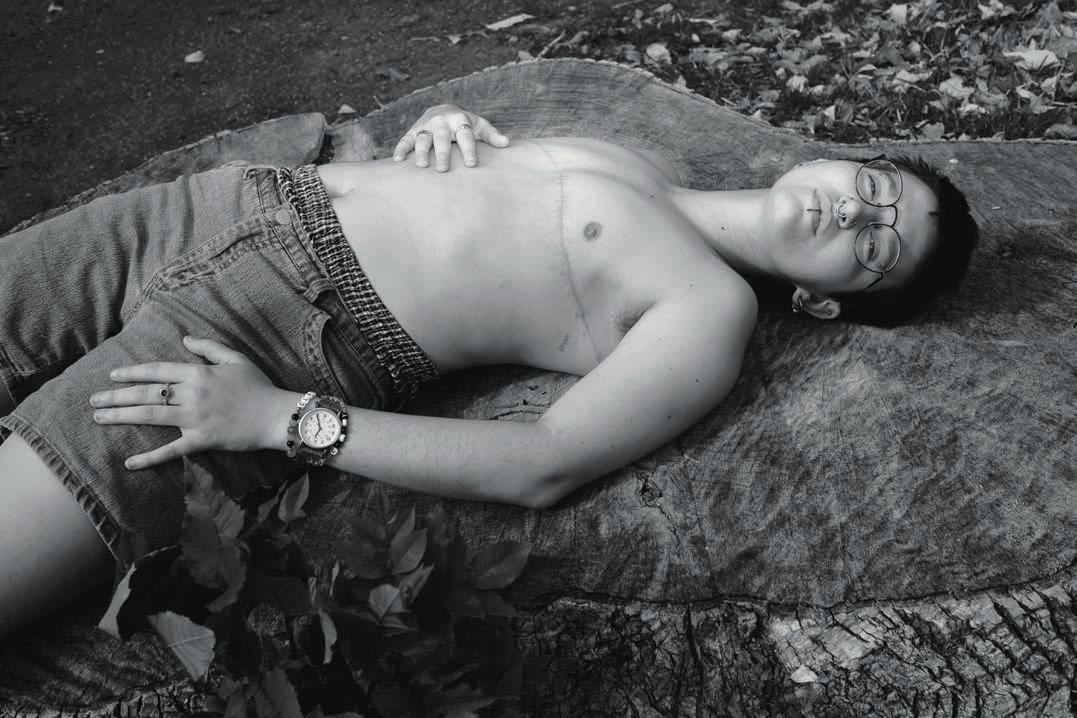

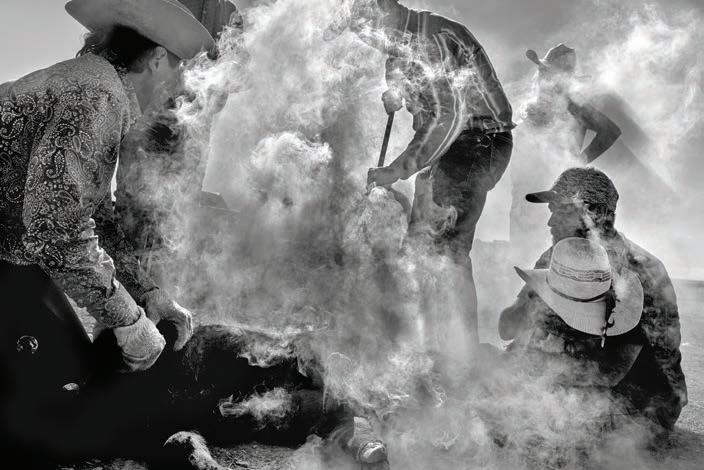
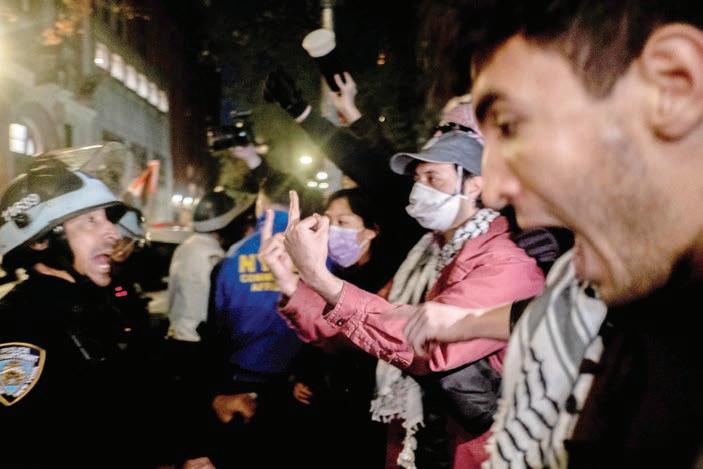

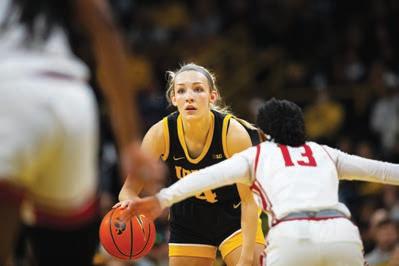
From the Paris Olympics to Iowa City
Gymnasts
Aurélie Tran and Cassie Lee apply their Olympic lessons to the Big
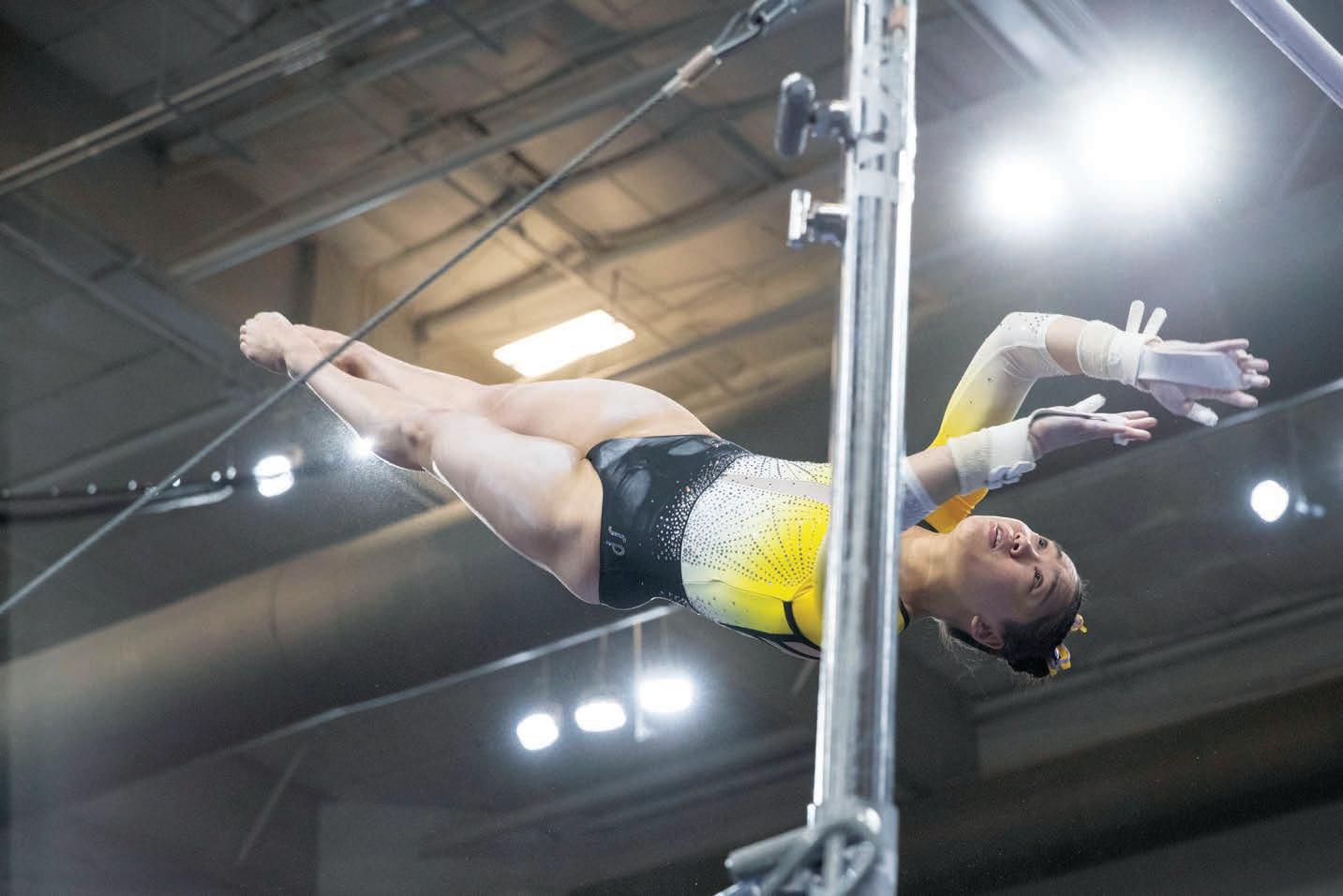
Aurélie Tran competes in bar competition during a gymnastics meet between Illinois and Iowa at Xtream Arena in

One in every 500,000 people becomes an Olympian. And Iowa has two of them. Aurélie Tran and Cassie Lee are only in their first years of competing as Hawkeyes, but their time as gymnasts goes back years prior. Representing Canada, the pair’s recent showing in the 2024 Paris Olympics marked only one of the most recent demonstrations of their athletic abilities.
“Being able to represent Canada at the biggest stage in gymnastics [was] just such an honor,” Lee said. “I was so grateful to be there and to be there with Aurélie because I’ve known her since we were babies. It was really great having a teammate that I’ve known for so long.”
Lee and Tran were highly-touted recruits with plenty of experience and skill, as they made the jumps to the Canadian national team and then to the Iowa Hawkeyes. Tran began gymnastics at the age of five, and her accolades include a 2023 Pan American Games bronze medal and three to match at the Pan American Championships that same year. This culminated in the first-year’s nomination to Team Canada in late June 2024 where she helped her country place fifth.
It is time for Iowa to change its coaching staff
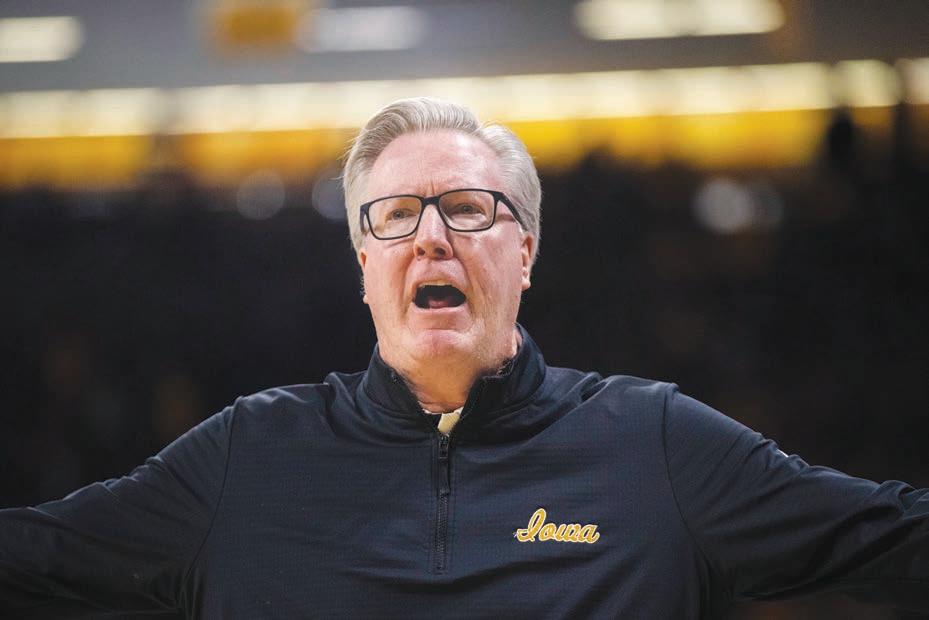

When Fran McCaffery took over as Iowa’s head men’s basketball coach in 2010, he inherited a program that was in ruins following the disappointing tenures of Steve Alford and Todd Lickliter. Returning the Hawkeyes to national prominence seemed like a difficult task for
but he had Iowa in the postsea-
in just year two, followed by his first
tournament appearance
who turns 66 in May, has led the Hawkeyes to six additional NCAA tournaments since then, but as the saying goes, “all good things must come to an end.” It’s time for new blood in Iowa City.
Though McCaffery is Iowa’s all-time winningest coach, he is about to miss the Big Dance for a second consecutive season in 2024-25 and might not even qualify for the Big Ten tournament. While the Hawkeyes have battled their fair share of injuries this year, that’s a pretty embarrassing thought for a program that has historically ranked in the upper echelon of the Big Ten. Iowa didn’t enter this season with massive expectations, but many fans hoped for at least a return to the NCAA tournament. Barring a miracle Big Ten tournament title run, that’s not going to happen. I believe there is a lot of talent on this roster, but the pieces just haven’t fit together for one reason or another.
And not only are the Hawkeyes losing, but they are also struggling to even compete with some of the Big Ten’s best. It’s one thing to lose close games to good teams, but Iowa
Lee’s path saw her run a similar gauntlet to that of Tran with bronze medals at the same Pan American Games in Santiago and, later, the Pan American Championships in Medellín. Lee also nabbed a bronze medal at the 2022 Commonwealth Games in Birmingham before joining Tran in Paris this past summer. Iowa first-year head coach Jen Llewellyn spoke highly of both athletes and
Cali Leng surging through the postseason
Leng had a disappointing 1512 record last year but turned things around this season.
Jackson Miller Sports Reporter sports@dailyiowan.com
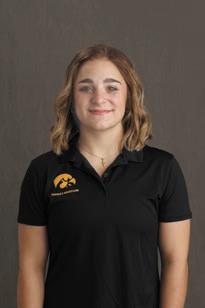
Iowa women’s wrestler Cali Leng stood atop the podium as the 124-pound champion at the NCWWC Region VII Championships in Indianola on Feb. 22, a position some believed she wouldn’t be in just a few months ago.
Leng put together a disappointing 15-12 record during her freshman campaign but vowed to turn things around.
“This time last year, I was upset,” Leng said. “I was watching my teammates compete, and I wanted to be there so bad and had been dreaming about being in this position since then. So, that really fueled me this summer, and I didn’t hold myself back from training. That’s fueled me the entire season this year and kept me wanting to compete every chance that I get.”
Needless to say, she improved.
The second-year Hawkeye was ranked outside the National Wrestling Coaches Association’s top-10 at 124 pounds before the season started. Achieving that mark didn’t seem very plausible for Leng during the first half of the season. However, Leng exploded in the second half of the year, becoming the No. 4 124-pound wrestler in the country and earning the NWCA Region VII Co-Wrestler of the Month for January. She attributes her newfound success to her strong pre-match mentality.
“A big thing has been my mentality going into each match,” Leng said following the NCWWC Region VII Championships. “Just getting ready for each match in a positive way, telling myself the right things, affirming myself knowing that even though I’m nervous, I know it’s there to help me, and it’s all going to be channeled into getting where I want to be.”
Leng shot up the rankings and appeared in the top 10 of the NWCA’s second edition of rankings in December and remained in that spot going into regionals.
At regionals, Leng dominated her way to a firstplace finish. She went 4-0 on the day, including a pin and tech fall in the first two rounds, followed by a 7-0
Men’s Basketball
Thursday, March 6
Michigan State Iowa City, IA
7 p.m.
Sunday, March 9
Nebraska Lincoln, Nebraska
Women’s Basketball
Wednesday through Sunday, March 5-9
Big Ten Tournament Indianapolis, Indiana
Women’s Wrestling
Friday and Saturday, March 7-March 8
NCWWC National
Championships
Coralville, Iowa
Men’s Wrestling
Saturday and Sunday, March 8-March 9
Big Ten Championships
Evanston, Illinois
Gymnastics
Friday, March 7
Iowa State Iowa City, Iowa
6:30 p.m.
Baseball
Wednesday, March 5
St. Thomas Iowa City, Iowa 4:05 p.m.
Friday, March 7
Louisiana Lafayette Tuscaloosa, Alabama
2 p.m.
WHAT YOU’VE MISSED
Iowa running backs coach
Ladell Betts has been named to the same position with the NFL’s New York Giants, The Athletic reported on Feb. 24.
Betts spent the past four seasons at his alma mater, helping the Hawkeyes to 36 victories during his tenure while coaching one of the nation’s top running backs in Kaleb Johnson in 2024. Johnson collected 1,537 rushing yards and 21 touchdowns during the campaign, breaking Shonn Greene’s previous school record of 20 touchdowns.
Betts had a standout career at Iowa under head coaches Hayden Fry and Kirk Ferentz from 19972001, finishing his career in second place on the Hawkeyes’ all-time rushing list with 3,686 yards during his tenure.
After retiring from football in 2010, Betts entered the coaching ranks and spent eight seasons at the high school level before returning to Iowa as running backs coach in 2021 under his former coach.
“Ladell is not a big talker, but he’s been a big doer throughout his whole career,” Ferentz previously told 247Sports. “I don’t think he was a big talker when he was here in school, but he was one of the toughest guys I’ve ever seen.” Now, Betts takes his talents to a Giants squad that ranked as one of the NFL’s worst rushing units, tallying only 104.9 yards per contest en route to a dismal 3-14 overall season mark. The move will also be a bit of a homecoming for Betts, as he spent nearly the entirety of his NFL career in the NFC East with the Washington Commanders.
QUOTE OF THE WEEK
Shuffled postseason lineups leave questions
Iowa still has questionable lineups for both the 125-pound and 141-pound weights.
Trey Benson Sports Reporter sports@dailyiowan.com
Fresh off a 21-16 upset victory over former No. 2 Oklahoma State in Carver-Hawkeye Arena, the current No. 2 ranked Iowa wrestling squad will be aiming to carry this momentum to dominate the competition in the postseason.
However, even momentum has its limits.
Iowa wrestling has a historic and famed past with head coach Tom Brands manning the helm. Brands and his coaching staff have been responsible for over 26 Big Ten champions, 13 NCAA champions, and over 104 All-Americans.
With post-season play rapidly approaching, Brands will have his work cut out for him in order to succeed in the postseason.
While the Hawkeyes boast a loaded roster, there are two bouts of uncertainty this season – the 125 pound and 141 pound divisions.
Recently, Joey Cruz has headlined as the guy for 125, accumulating an overall record of 14-9 in the regular season after facing a grueling schedule of topranked opponents.
While 14-9 may cut it in other wrestling programs, in order for the No. 3 ranked Hawkeyes to be successful in the postseason against top-ranked foes such as No. 1 Penn State and No. 2 Oklahoma State, every bout needs to produce at the highest level possible.
Brands said it best in a postmeet interview following the Hawkeyes’ comeback 19-16 win against No. 7 ranked Nebraska.
“It’s a 10 cylinder engine that it’s running on. Pick your number,”Brands said. “We have to be running on 10 -ylinders, and that’s all I really want to say.”
Cruz has had momentous moments for the Hawkeyes as the starting lightweight, most notably taking down No. 18 Nicolar Rivera of Wisconsin and No. 16 Brendan McCrone of Ohio State.
However, Cruz’s biggest trou-
Q&A | KARINA MUÑOZ
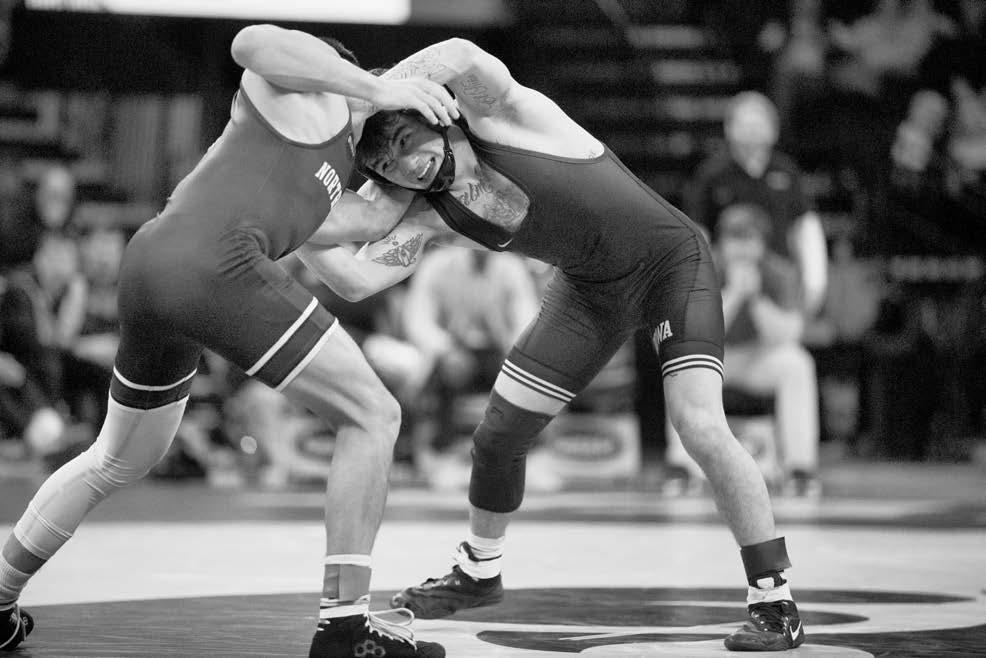
ble lies in consistency, as the Fresno, California, native got shut-out in Iowa’s dual against Army to No. 22 Charles Farmer, 8-0. Cruz also dropped the first
the best shot at winning a 39th conference title.
“Well, it’s more of doing it for yourself. You know you want to be better for yourself,” Cruz said.
“You’re not worried about what spot and who’s getting it. You’re worried about going full limit every day and becoming the best version of yourself.”
Joey Cruz Iowa 125-pound wrestler
match of the year to No. 27 Max Renteria, 6-4. This loss by Cruz led to Brands giving Kale Peterson the start at 125 pounds for three consecutive duals in a row. Cruz will need to find a groove in the Big Ten conference tournament to give Iowa
141 pounds has also been a distinct area of improvement for Iowa with three different wrestlers taking the nod at different matches throughout the season – Jace Rhodes, Cullan Schriever, and Ryder Block.
Out of the 10 bouts for the
Karina Muñoz discusses IC favorites, inspiration
Morgan Burhans Sports Reporter sports@dailyiowan.com
The Daily Iowan: If you didn’t play gymnastics, what sport would you play?
Karina Muñoz: I think I would run track. Back at my school, we did a bunch of track events, and it’s something I was always good at. The track coach always asked me to join the team, but I never had the time because gymnastics was full-time.
What’s your favorite thing to do in Iowa City?
I would say eat. I love The Dandy Lion. I go there probably three times a week. All of the waitresses know my order by heart. They never give me a menu. I walk in, and they’re like, ‘I’ll put in your order, Karina.’ They give
POINT | COUNTERPOINT
me my coffee, and I always just take everyone there, so that’s a spot I have been going to since freshman year.
Hawkeyes, the third bout has seen the most losses this season going 5-10 through 15 duals. Through this time frame, Rhodes has conquered one win while Schriever and Block have two wins each.
It’s unclear who Brands will start at 141, but one thing is apparent – for Iowa to compete at the highest level, the third bout has to find a way to victory.
Earlier in the season, Brands discussed the reasoning behind the different lineup decisions at the 141-pound weight.
“Schriever could have went at 141,” Brands said. “Those two guys [ Schriever and Rhodes], we have confidence in both of those guys. Rhodes was in his first Big Ten dual. Schriever has been on the mat more. And it was my call”. It was my call.”
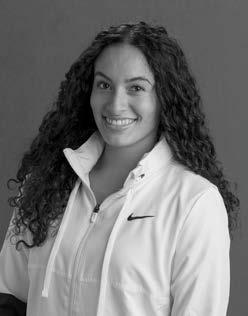
Why Iowa? I always wanted to go out of state for college. So, when I first came here, everyone was like, ‘Why are you going to Iowa?’ I didn’t really know Iowa and had never been here before, but when I came here it was something that was different from New Jersey. It seemed like a place I would feel comfortable in, and when I came here, I really liked the campus. When I talked to the coaches, it was a really good fit for the time, so I made the change to come here.
What is your favorite memory doing gymnastics here at Iowa?
Getting a 9.95 on bars my sophomore year at our Big Five competition just because
it wasn’t something I was expecting.
When I saw that score, I was like, ‘Oh my, God,’ and it was a career high for me.
What advice would you give to other aspiring student-athletes?
Never take any moment for granted. You’re only here for four years, and some people dream about being in the position you’re in. So, go everyday and practice. At least try your best. If you only have 70 percent that day, give it that 70 percent because some people can’t do it. It’s a short portion of your life, so why not make the most of it?
Where do you see yourself in 10 years?
Probably working for ESPN. It was a switch I made last year with the path of my career. It’s something I want to do, get into broadcasting or reporting.
Where will Iowa men’s wrestling finish?

The reason we have dual meets in the regular season is to outline what the postseason will look like — and the Hawkeyes beat all but one opponent there for a reason.
“There’s nothing like it best moment in my career. I can’t be more thankful.”
Freshman Hawkeye
wrestler Angelo Ferrari
after an upset win over Oklahoma State’s No. 3
Dustin Plott, winning him Big Ten Wrestler of the Week honors
STAT OF THE WEEK
Points from Iowa women’s basketball guard Sydney Affolter in a 79-66 win over Michigan on Feb. 26, a career-high
It’s safe to look past who will finish first at the Northwestern-hosted Big Ten championships in Evanston, Illinois, at Sunday’s conclusion. Penn State’s dominance across the board almost guarantees a handful of Nittany Lion Big Ten champions if not an NCAA title come mid-March.
So, the question is now a matter of who will again be right after them. And it’d be foolish to pick against the Hawkeyes.
“Tough tests” are a cop-out answer in a desperate search for some sort of worry about head coach Tom Brands’ squad. But losses are losses. Nebraska lost. Ohio State lost. Minnesota lost. Illinois lost. Then-No. 2 Oklahoma State lost, too. The Hawkeyes have
proved time and time again they stand above — most of — rounding competition. Home field advantage is a fair argument, but no team really has it at Northwest ern — not even Northwestern. It comes down to the best wrestler at each level. Sure, serious runs deep into the bracket will be tough to find at 125, 141, 174, 184, and heavyweight. But Hawkeyes are ranked in roughly the top 10 at the latter three classes, making third or fourth-place finishes point-worthy results for this team’s total. Losing is important. The Nittany Lions haven’t done much of it, but the Hawkeyes have done just enough to learn how to win the right way. Kyle Parco, Michael Caliendo, and Jacori Teemer have the toolboxes to make serious noise in second-place finishes or even a championship with a stroke of luck. And Iowa should be guaranteed Big Ten champions in Drake Ayala and Stephen Buchanan — serious point-scorers. Barring upsets, Brands’ lineup captures second with ease so long as it sticks to the script. But it’s a shame we have to yet again debate who’s going to finish runner-up. Competition for first place makes wrestling much more interesting.

Third
The No. 2 Iowa men’s wrestling squad is hunting for its 38th Big Ten title, but the conference powerhouse makes anything better than third at the Big Ten championships a tall task.
This season, competition in the Big Ten is as fierce as ever before, currently holding half of the top10 ranked teams — giving Iowa wrestling one of the more grueling journeys to a conference title in recent memory.
The battle for second place behind the dominant Penn State Nittany Lions presumably has Iowa as the second favorite heading into the tournament. However, No. 5 Nebraska and No. 6 Minnesota will be eyeing the Hawkeyes looking to avenge their respective dual losses suffered in the regular season.
This will surely put Iowa wrestling on upset alert, as the Hawkeyes narrowly escaped Nebraska, 19-16, on Feb. 7. Ral-
lying a comeback win in the final two bouts proved Iowa can take a celebrated victory over the crossstate rival. The comeback win showed Iowa can perform under intense pressure. But if this dual were not in Carver-Hawkeye Arena, the results could have been very different. Nebraska will undeniably be looking to take advantage of the neutral site in Evanston, Illinois, during the conference tournament. Iowa also defeated Minnesota, 23-11, on Feb. 14, yet the score does not tell the entire tale of the dual. The Hawkeyes took seven out of 10 bouts over the Gophers yet only recorded four more takedowns throughout the match.
If Minnesota utilizes the two weeks of preparation to its full potential to focus on Hawkeye weak points — especially at 141, 174, and 184 pounds — Iowa wrestling may find itself in a hole to the Gophers come conference tournament time.
Again, at a neutral site, anything can happen.
Iowa wrestling will have two weeks to start firing on all cylinders, and I fear a possible upset from either Nebraska or Minnesota will send the Hawkeyes back to Iowa City with a third-place finish in the conference tournament.
expressed gratitude for what the two recruits have brought to the team.
“We got really lucky that they were already committed here at Iowa,” Llewellyn said. “I keep saying our job is to make sure they have a great experience and that we keep them. I am super grateful for both of them. It’s been a tremendous experience to be able to have their experience on this team and their maturity.”

Both of the new additions have put up high figures to aid the Hawkeyes in recent meets. Of Iowa’s three Big Ten dual wins, two of them have been upsets against ranked foes, namely No. 25 Nebraska on Feb. 1 and No. 26 Illinois on Feb. 16.
Tran specifically shined during a 196.350-195.700 road victory over the Cornhuskers, leading the Hawkeyes as the meet’s highest all-arounder.
The first-year student from Quebec posted a 9.775 on vault and a 9.825 on bars before nabbing a 9.875 on beam and a 9.850 on floor, good for a 39.325 all-around score. Iowa outscored Nebraska in every event except floor to pull off the upset.
“She’s an amazing gymnast to train with,” Lee said of her teammate. “She’s such a hard worker. I’m just so proud to see how far she’s come with NCAA.”
Lee also noted the camaraderie and competition between herself and Tran that pushes both to perform well.
“I love the competition between our team and the other, but for me and Aurélie, I feel like we both push each other to do better,” Lee said. “I feel like I’m always competing against her. She’s doing amazing.”
Lee’s own strengths have consistently been on beam, grabbing high scores across multiple duals this season.
In Big Ten matchups especially, the first-year student from Toronto has led by example. Lee’s lowest average beam score in a Big Ten dual was a whopping 9.400 in a 197.325-195.625 loss to Minnesota on Jan. 26. Her highest, on the other hand, where a 9.875 against the Cornhuskers, where a 9.85 and a near-perfect 9.90 put Lee in a five-way tie for the best score of the event.
While Lee’s career has seen her consistent across all four main events, such as at the 2019 Junior World Championships, prioritizing her health and safety this season led to beam being a focal point.
“Beam has always been one of my best events, so I was really excited to compete [on] it for college,” Lee said. “I’ve
has lost six games on the road by double digits, including losses by 31 and 26 points at Maryland and Wisconsin, respectively.
Then there’s the Sweet 16 issue. Despite producing the likes of Luka Garza, Keegan Murray, Kris Murray, and so many others, McCaffery’s Hawkeye squads have never once reached the second weekend of the NCAA
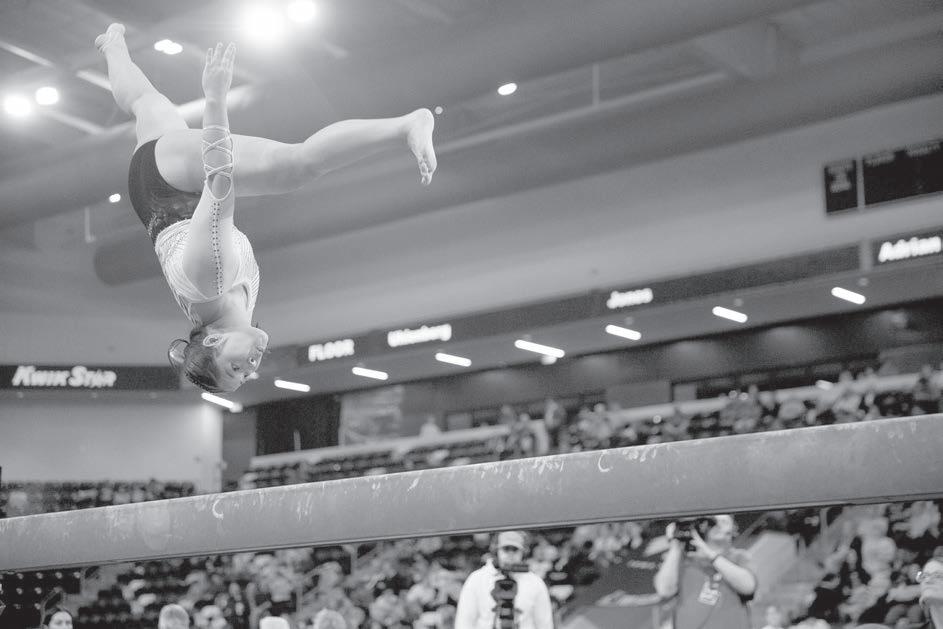
been mostly focusing on beam this season just because there’ve been a couple aches and pains during preseason, and we decided it was best to focus on beam for this season, especially coming off an Olympic year for me.”
The numbers Tran and Lee put up have worked miracles for the Hawkeyes, helping them with the two upsets the program has so far achieved this season. Llewellyn, in particular, praised Tran’s reliability as an athlete.
“What’s most amazing about her is that she’s very consistent in what she does, not just with gymnastics and the skills that she’s doing but in how she takes care of herself,” Llewellyn said. “She does a lot of extra mobility or rehab or prehab stuff on each event that you can tell she brought over from the elite world.”
Llewellyn also noted admiration for Lee’s vocals and ability to step up as a member of the program.
tournament. That’s an accomplishment the program hasn’t earned since 1999, but with the way things are going, it’s hard to see McCaffery come close to making one at this point in his tenure.
The Hawkeyes’ on-court issues are certainly telling, but to me, the primary reason it’s time for a change is the ongoing attendance problem in Carver-Hawkeye Arena. Sure, it’s one thing to experience a decrease in attendance during a down season, but this
has been something that has been a problem for years.
McCaffery’s up-tempo offensive style was initially praised for bringing enthusiasm back to Iowa basketball, but the bad combination of poor defense and rebounding has soured the minds of many fans. It hasn’t helped that McCaffery has refused to make any changes to that gameplan, further angering fans who correlate that style with the lack of success in March.
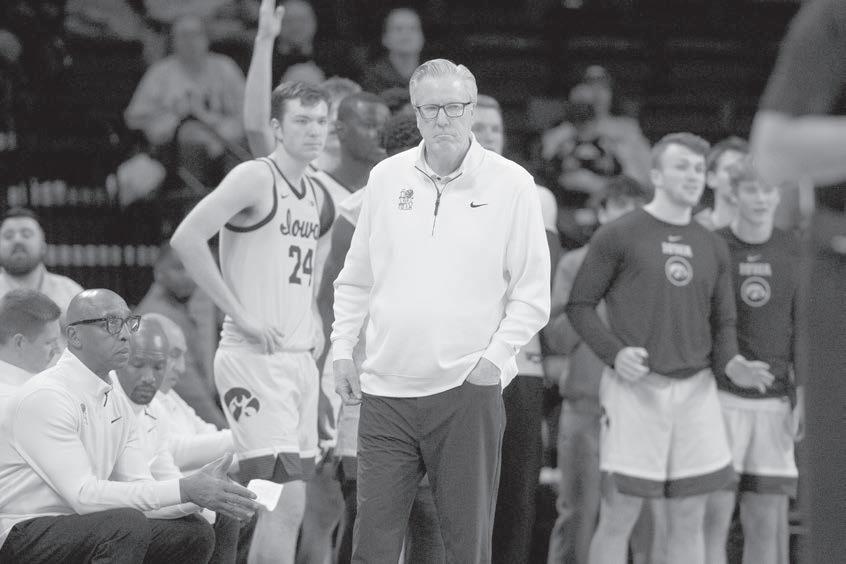

decision win in the semifinals and a tech fall victory to take the title.
“All season, she was probably considered the underdog,” head coach Clarissa Chun said after the regionals tournament. “This was her first competition being seeded, and how she took that and framed
and competed today was no different than how she has competed all season.”
Leng has shown marked improvement in many areas of the game, but she credits her practice routine and new techniques as the primary factors that could help her surge into the postseason.
“I feel like my chain wrestling has gotten a lot bet
ter,” Leng said. “Wrestling through positions without stopping. That’s something that just happened with constantly wrestling in the [practice] room and trusting myself knowing that I can wrestle through any position.”
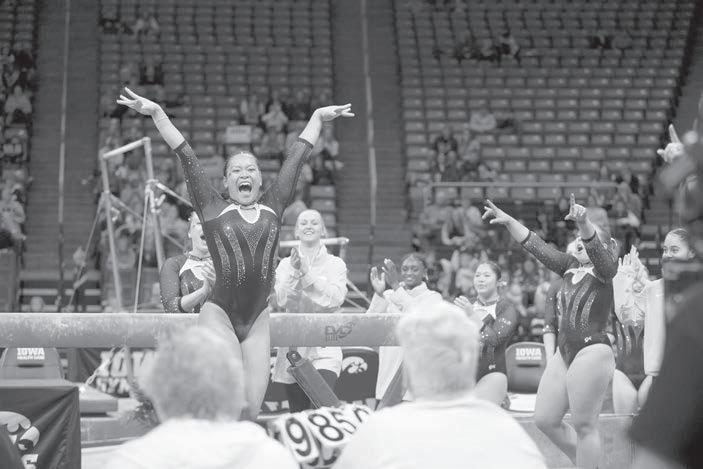



“There’s been a lot of moments in the gym and in competition where Cassie isn’t afraid to speak observations or things that are going on,” Llewellyn said. “She speaks as if she’s a veteran or a returner. You don’t usually hear freshmen speak up a lot or give their feedback on observations that they have. I think she just brings a level of confidence, a level of maturity, because of the experiences she has.”
Thus far, Iowa has broken even in dual meets at 3-3. With the CyHawk meet on the horizon, the Minnesota Quad just over a week later, and the Big Ten championships in Ann Arbor on the way in less than a month, the Hawkeyes brace for intense competition.
“I’m very excited to see how they’re going to continue to grow in college and really just come out of their comfort zone,” Llewellyn said. “Big things are in store for them in their four years here at Iowa.”
Two weeks ago, Chad Leistikow of The Des Moines Register reported Iowa averages roughly 5,000 tickets scanned for men’s basketball games. Remember, that’s the amount of people who are actually in the door, not the phony-reported announced attendance.
That’s when the athletic department really needs to get involved.
If the Hawkeyes were still drawing in respectable crowds to games, they may sway toward keeping McCaffery. Since that’s not remotely the case, it causes the university to lose money on not only ticket revenues, but also alcohol and food sales. By not showing up to games, the fanbase is telling Athletics
Director Beth Goetz they want a change. There is no business without the fans, and if they want change and seem checked out, then it might tell Goetz she needs to rip the Band-Aid off before things continue to go downhill. While Iowa fans should still consider the McCaffery era a success, it’s clear that the program has reached its ceiling under its longtime coach and is desperate for a new look. There’s no guarantee that a new head coach would have the same level of winning history as McCaffery, but it’s a risk that Goetz must take in order for this program to return to national prominence.



BIG TEN TOURNAMENT-BOUND
The Iowa women’s basketball team defeated the Wisconsin Badgers, 81-66, at a sold out game featuring Senior Night and the closing of the regular season.
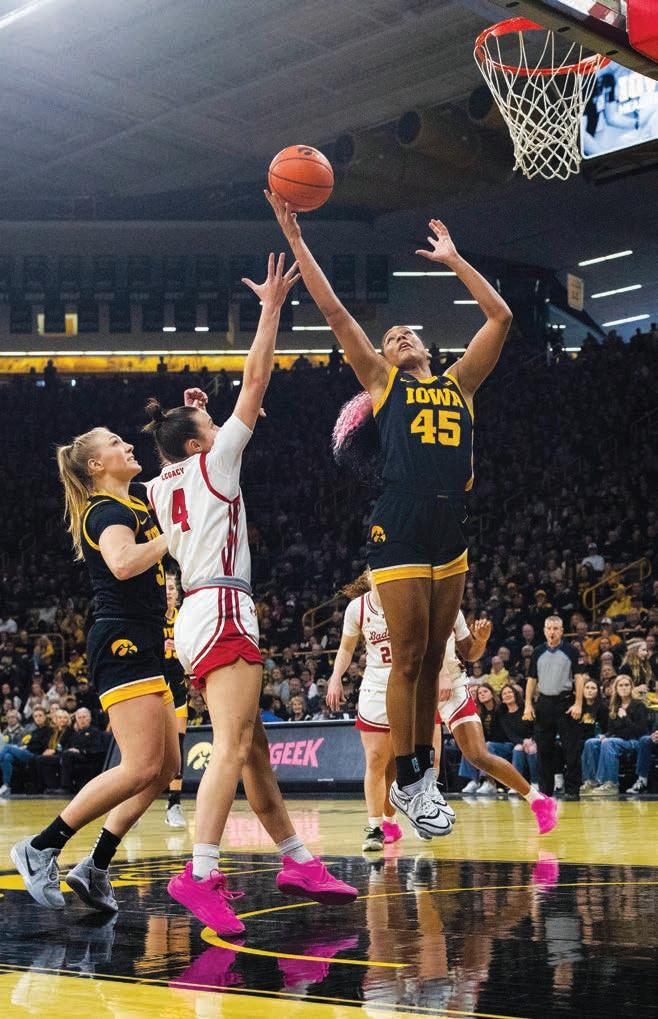
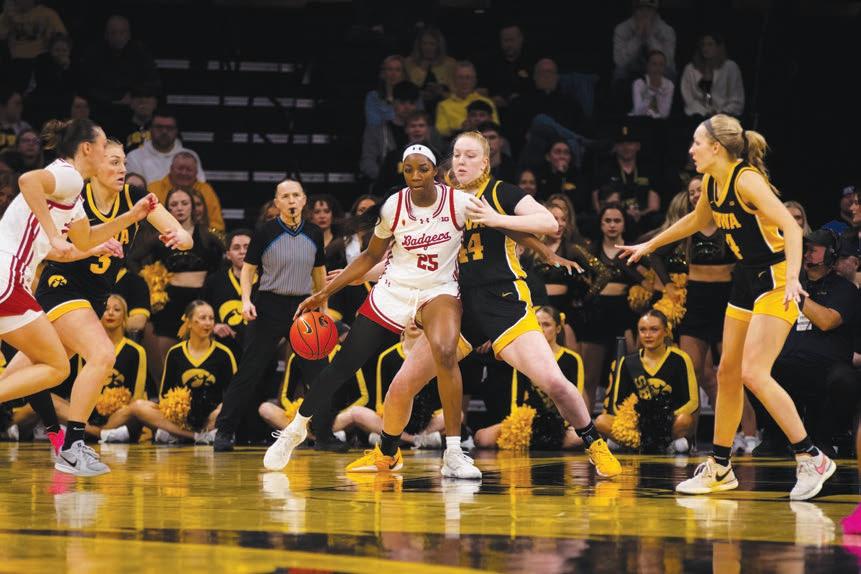
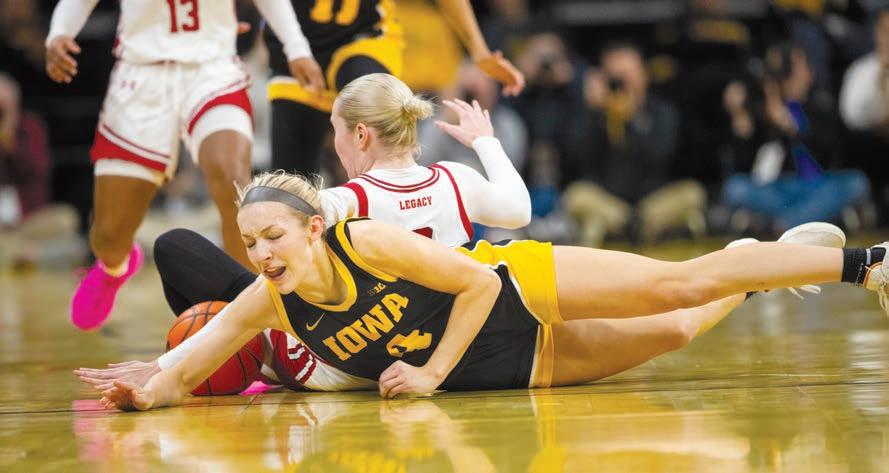


Brain rot is no laughing matter
UI students and faculty weigh in on the popularity of short-form video content and its influence on mental health, the way people speak, and the media people consume.
Voxman studios encourage student music production
RECIPE
Roxxy’s Dead Nazi shot
• Jäegermeister
• Rumple Minz
See the review online
Catch the full review of the Dead Nazi shot and past cocktail columns from around Iowa City online at dailyiowan.com.



While the Voxman studios remain booked, local musicians are recommended to other local studios.
Charlie Christensen Arts Reporter arts@dailyiowan.com
In today’s media ecosystem, it has never been easier to consume music. With streaming platforms, social media, and digital downloads, it is possible to enjoy a vast library of songs from all over the world at the touch of a button.
However, as an artist, it can be tricky to record music. Knowing what equipment to buy, where to get it, and for the right price has become extremely difficult. The University of Iowa’s Voxman Music Building has been a reliable place for school of music students to go and record CDs or albums.
Even so, the Voxman studios' packed schedule can make securing a slot difficult.
“There's about 450 music majors and around 60 faculty. We record or do live sound and video for probably 300 to 350 shows a year, and there's around 15 to 20 full-length CDs a year,” James Edel, UI music production manager, said regarding the studios' fully booked schedule. “It's just a

PROFILE
The rise of Letterboxd and Goodreads leads users askew
Rating apps and websites lead to a new way for people to view new movies and books.
Kyrsten White Arts Reporter
arts@dailyiowan.com
Lily Kopp Arts Reporter arts@dailyiowan.com
The smell of popcorn fills the theater as the lights begin to dim, and the screen stretches to the perfect size for the newest movie everyone is buzzing to see. But the only thing on the audience’s minds is what line they think is the funniest so their Letterboxd review gets the most likes.
Dating back to the early 2000s, rating apps like Goodreads and Letterboxd entered the pop culture world to help people keep track of people’s opinions on their favorite, or least favorite, books and movies. It was not until the pandemic that these websites garnered real attention.
University of Iowa second-year student Hannah Rechlicz uses reading to wind down from her accounting and finance classes. To keep track of the books she reads, she’s been using Goodreads, an app that lets you rate, review, and check your reading progress of different novels, for the past year.
Although Rechlicz doesn’t write reviews for the books, she checks them off her “Want to Read” list and finds the reviews and ratings affected her decision to pick up a book. While reading reviews, she’s looking to see if people generally enjoyed the book or if it was a total bust.
“Is it a really, really good book? Or is it just OK? If I see probably more than, like, six or seven one stars, I'll probably push it off,” Rechlicz said.
When it comes to rating her own readings, Rechlicz tends to be generous, giving between three and five stars depending on how much she enjoyed the novel.
Rechlicz also uses Goodreads to connect with her aunt. They discuss books they’ve both read, and books are recommended to them based on what the other is reading.
Even though Rechlicz uses reading as an escape from her courses, she also creates competitions with herself. Goodreads lets you set goals, such as reading a set number of books in a year and keeping track of your progress, a feature Rechlicz utilizes frequently.
“I read 48 books in 2024 … I set my goal to 50 this year, so I've read about 13,” Rechlicz says.
While Rechlicz has had an overall positive experience on Goodreads, many people do not see these types of apps the same way. Although he did not have an entirely negative opinion toward Letterboxd, graduate student and filmmaker Arman Hodasefat finds the site to be a little too much.
“It got to a point where there is just too much material to follow, and I stopped,”
Hodasefat said.
With over 17 million users as of January 2025, the amount of content and reviews on the app can easily overwhelm anyone. Especially when looking into the large number of reviews listed under every movie.
Having public reviews for each movie on the site can easily muddy someone's opinions about a movie before they see it. Hodasefat described the many ways this app has changed how society goes into views a film.
“I was reading so many different things, and it also was changing the culture of how we see movies and how we write about movies, like funny one-liners,” Hodasefat said. “There were too many of those happening, and it was becoming meme-able.”
UI first-year student Jack O’Hern also noticed these trends of how Letterboxd can influence an audience’s ideas of a movie.
“Letterboxd can kind of kill a movie before it’s even out, in a way,” O’Hern said. “So, if everybody in the world says this movie sucks, and you’re like, ‘Okay, great, I’m not going to watch it,’ then you don’t know if you could get anything else out of that.”
O’Hern also acknowledged the change in culture is not necessarily a bad thing. There is now a greater sense of community across the movie-viewing world, especially with the ability to follow friends or strangers on the website. Even though it has more of a “social media” feel to it now, it also plays into allowing people to connect more with others.
“So, if you’re going on Letterboxd, and you’re saying these are my top four movies, that lets other people know certain things about you that you want to put forward,” O’Hern said.
lot.”
However, there is still room for bands outside the school of music to use the recording studios. One band has been recording their first official pieces of music set to appear in their debut album. One More Hour is a local theatrical folk-rock band who recorded their music at the Voxman studios.
“We're really into the songwriting process. It's very collaborative. We’re really into writing story songs, and we pull from Irish tradition, American songwriter tradition, and Midwest Emo, and we try and put it all together,” band leader Finnegan Angelos said about the band.
Finnegan Angelos, Liv Caskey, Iris Savage, and Bella Nekvinda are the official members of the band.
The band has also worked with Matt Sleep, Sara Lyons, and Milo Savage-Webster to help with the recording process, even though they are not officially part of the band.
One More Hour is a band composed of a variety of different instruments including the cello, trumpet, guitar, fiddle, and more. Their instrumental diversity have makes it very possible to achieve this niche sound they’re looking for.
The band said Voxman was the perfect size because of the layout of their studio. All the instruments, microphones, and musicians could be set up in a large recital hall and not feel congested.
“We were considering a couple different places, but then the opportunity came up. We thought, this is kind of perfect,” Angelos said.
The studio they use has a control room that is wired throughout the building. This is different to the stereotypical recording studio where each room has its own control room. The producer will sit and watch the band via cameras and control the sound from there.
“Everything is really high-end. James Edel has been improving the studio for maybe ten years. It keeps getting better every year,” Shu-Min Alice Chang, UI audio and video coordinator, said about the technology Voxman offers.
Although Voxman is not as accessible to non-music majors, Edel and Chang remind students there are other places in the city to record music. Flat Black Studios is the place Edel refers hopeful musicians to who cannot find a spot at Voxman.
“You could probably go there for three days to record drums for a price that would get you not hardly enough mics and stuff to record drums yourself,” Edel said. “Also, they would have way better microphones than anyone would buy for their apartment studio.”
Editor’s note: Bella Nekvinda is a former staff member of The Daily Iowan.

STUDENT SPOTLIGHT
Triple threat undergraduate student takes on Ten Minute Play Fest
University of Iowa student, writer, actor, and director Sara Alvidrez returns to the stage.
Laurel Preston Arts Reporter arts@dailyiowan.com
“I once heard a playwright explain ideas and story-making like marriage. It’s nice and beautiful and fresh when you’re in the first couple years, or months in the honeymoon phase. But, whether or not it will last, it takes cleaning out the bathroom, doing the fine-tuning, and editing of the play,” Sara Alvidrez, a third-year student at the University of Iowa, said. “If it survives that, then it's going to last.”
The end of February marked the UI’s annual Ten Minute Play Festival. This threeday-long event featured readings and staged plays from undergraduate students brave enough to submit 10-minute-long pieces of theater. The topics this year ranged from a retelling of Adam and Eve and their Garden of Eden to a housewife planning to kill her abusive husband.
Nestled between these large genres of works was Alvidrez, who had two pieces featured in this year’s festival. The first, “Beers and Queers,” is a tale of sapphic love in the '50s. “I Hate You Kyle Busch,” her second piece, is a heartwarming examination of grief and the sweet friendship between the oddest characters.
“For ‘I Hate You Kyle Busch’ I just thought it would be nice to talk about grief funnily,” Alvidrez said. “I wanted to bring more humanity to the weird girl that has mismatched clothes and is kind of mean, or the janitor that is nice and people take for granted. People can bond in the weirdest of places, and knowing you’re not alone is important.”
This is not Alvidrez’s first time writing for the university, nor is it her first time putting on another hat besides the usual acting cap she frequents.
Her writing has previously been a part of the Ten Minute Play Festival, and she has directed many a piece for the UI.
“Everything depends on where my heart takes me. Don’t do something if you don’t feel called to do it,” Alvidrez said. Between last year’s Ten Minute Play Fes-
tival and now, Alvidrez spent five months studying abroad and didn’t write a single page of theater the whole time. When she returned to Iowa, she was motivated to further explore her artistic perspective.
“Initially I thought I was only an actor coming into my theater major, but now that I have directed, I realized the way my perspective and my brain works for comprehending theater is more of a directorial perspective,” Alvidrez said.
Alvidrez talked highly about the UI and the friends she made along the way influencing her evolution as a writer and director. The university and the community she built during her journey through the department helped her write and finalize her scripts for the Ten Minute Play Festival.
“Watching Sara grow as a director and writer has been incredible. Since we met my freshman year, she has been so determined to hone her skills and become the best artist she can be,” third-year student Maddie Rodriguez said. “She is full of talent and kindness and seeing her acknowledge her own abilities is truly beautiful.”
From creating the script in her third year of a playwriting class to sitting down with her friends and hashing out the details of the piece, Alvidrez used the university community as a tool to create art that would inspire others. This helped her build her philosophies around writing while getting more and more experience in the field.
“I think and brainstorm of different moments at the pinnacle of plot and character. I am of the group that the play tells you what it wants to be. Once you allow it to, the more you write it, the more the characters will become themselves, and the more you talk to them and think about them as real people in the context of which they’re living. That helps it prosper,” Alvidrez said.
The meme culture making us go grey

Charlie Hickman Arts Editor charlie.hickman@dailyiowan.com
Isabelle Lubguban Arts Reporter arts@dailyiowan.com
The first thing students like Justis Walker do when they wake up is open Instagram and start scrolling through Reels. Phones resting mere inches from their faces, images of dancing fruit and AI-generated videos of Shrek fighting Lebron James project onto students’ bleary-eyed faces, injecting their brains with the proverbial “rot.”
The “brain rot” phenomenon is a leading factor in the mental health crisis among young adults with its dopamine-inducing tendrils reaching from beyond the screen and into daily life. Brain rot was even named Word of the Year by the Oxford University Press in 2024.
“Brain rot is a type of meme culture. People have inside jokes online, just like any other interpersonal relationship,” Walker said. “They might [be reminded] of a certain place where something funny happened — little things.” Walker is a second-year student at the University of Iowa and described some of the biggest social media trends in recent years as brain rot. Words like “rizz,” “huzz,” or “skibidi toilet” are sayings that have spread across social media but originated in comedic TikToks or Instagram Reels.
Words like these have to elicit a reaction in order to gain the traction they end up garnering, according to Walker. The more provocative or buzzy the brain rot

saying, the more likely it will catch on.
“Cat videos easily go viral because when you see a cat, you feel affection. The same thing happens with funny videos because you laugh at them,” Walker said. “That’s why rage-bait is becoming more prominent. It’s just about what gets people talking — what makes people feel something.”
This ethos is what the internet has run on since its invention. Memes and viral jokes have always been passed around — the form is what has changed. Despite recently entering the cultural vocabulary, the term brain rot has been around since 1854 when Henry David Thoreau coined the term in his book “Walden.”
After abandoning the material world, Thoreau lived a peaceful life, in nature and documented his experience in “Walden.” Transcending modernity, Thoreau bemoans the mental decline of those still taking part in contemporary life asking, “Will not any endeavor to cure the brain-rot which prevails so much more widely and fatally?”
Even at its inception, the term referred to invaluable thinking. In this digital age, invaluable thinking translates to social media posts. The term reentered the zeitgeist in 2020 when Reels and TikTok gained popularity.
UI third-year student Ben Benton believes the rapidity of brain rot is largely responsible for the uptick in this content. Benton compares these quick-cut videos to the appeal of “fail” videos.
“Both are humorous because they give a sudden outcome to a situation that you didn’t necessarily expect,” Benton said.
Much like the buzzwords that get thrown around

Edited by Will Shortz No. 0129



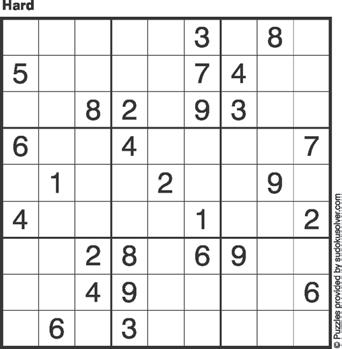
in brain rot content, there is a shock value in the structure of the videos. Anyone who has been on the internet can tell you trends come and go. Benton believes the brain rot trend may just be another in a lineage of viral videos like fails or Vine skits.
Diluting humor to shorthand language and bitesize videos meant to do nothing but pacify the brain with patterns of quick dopamine hits is where the rot part becomes concerning. After any extended screen time, it’s common to feel lethargic despite not moving at all. This lethargy is compounded by overstimulating scrolling through brain rot content.
Researchers deem any sort of online content that negatively influences cognition or mental health as brain rot. Negative news posts are considered brain rot despite not fitting the trendy format. These posts are put out in the same snappy, constant flow as comedic ones, and an overexposure can lead to seriously distressing feelings.
Even though brain rot video content doesn’t directly deal with negative subject matter, the post-scroll feeling can be eerily similar. Overstimulation of any kind can lead to problems with problem solving, decision making, memory, and organization.
The parts of the brain that influence these functions can be physically altered by grey matter — the rot is literal, and it’s seeping into nondigital areas of life. In October 2024, brain rot mascots A.J. and Big Justice joined The Rizzler on “The Tonight Show.”
“Film went through a similar phase in the early 1900s. People were assuming that going to see movies was going to have a detrimental effect on people .”
Zachary
Vanes
University of Iowa graduate student
If all of that sounds foreign to you, that is likely a good sign.
These viral Costco shoppers who have been the stars of countless brain rot videos were invited to perform their internet gimmick on the same show celebrities frequent. This episode blurred the lines between internet star and celebrity, setting a precedent for the normalization of seeing the figures from our phones in real-world scenarios.
If the real-world effects of internet brain rot seem dire, one article from The Atlantic in 2008 may offer some hope. 17 years ago, the publication released a story titled “Is Google Making Us Stupid?” and raised similar concerns to those expressed by professionals about brain rot.
As new forms of digital tools and entertainment emerge, so too do concerns for what dangerous impacts could linger around the corner. This cycle isn’t exclusive to the internet, though.
“Film went through a similar phase in the early 1900s. People were assuming that going to see movies was going to have a detrimental effect on people,”
Zachary Vanes, a graduate student at the UI teaching classes in the Department of Cinematic Arts, said. “There is this perennial idea that the amount and type of media you consume is going to influence how you think and behave.”
While Vanes does believe there is stock in the possibility that brain rot content could be influencing how young people’s minds work, he finds it to be more of a scapegoat than the root cause.
“I think a lot of things, like attention spans, are related to the hours that we are expected to work and the culture that we live in,” Vanes said. “The media comes after the culture.”
Vanes pointed to recent remakes of animated Disney films as a signifier of film following the culture. At a point where people want easy-to-swallow content they don’t have to think about, film studios are looking for ways to cash in.
“The industry has always sort of relied on things that are tested. If something works, like princess movies, they’re going to keep making them until they can’t. The idea that profit is more important than anything else is most prevalent. Right now, they are catering to brain rot spectators,” Vanes said.
While brain rot has already permeated the film industry, Vanes does not see the potential risks of brain rot slang. He finds abbreviations and shorthand to be a natural function of communication.
“There’s a process known as chunking where what you hear consolidates in a sort of chunk that you can access through memory. Shorthands simplify the process,” Vanes said.
From a student’s perspective, shorthand is so ingrained in how young people communicate that Walker believes brain rot does nothing new to further complicate things.
“I feel like it is a form of creativity,” Walker said. “To make something very unique within itself. We all have a good idea of what professional language is It depends on who you’re talking to. Linguistics is not something that is set. It’s always evolving and always changing.”
Walker believes even the most staunch critics of brain rot terminology won’t need to worry for long. Just as soon as a phrase like “Kamala is BRAT” makes its way from TikTok, to Instagram, and then Facebook, it will already have been replaced.
“Meme culture is part of the media,” Walker said. “Things come and go, and memes die and rise.”
The revolving door of the internet shuffles in new trends every day, but only some of them end up taking off so far as
to influence language and film. Given the unpredictability, Vanes can see a future where brain rot is hailed as an art form.
“Right now, we think that TikTok is affecting our brains, but 20 years from now, we might encourage our children to watch TikToks because it’s good for them,” Vanes said.
The popularity of brain rot could be the source of many consequences — some
good and some not. Whether videos of people dancing while pointing at text boxes above their heads continue to enrapture the culture or become replaced by some inconceivable next step in Thoreau’s original brain rot theory, selfmoderation on the internet is as important as ever. “Media is defined by the power that we give it,” Vanes said.


